
About UsThe Numismatic Bibliomania Society is a non-profit organization devoted to the study and enjoyment of numismatic literature. For more information please see our web site at coinbooks.org SubscriptionsThose wishing to become new E-Sylum subscribers (or wishing to Unsubscribe) can go to the following web page link MembershipThere is a membership application available on the web site Membership Application To join, print the application and return it with your check to the address printed on the application. Membership is only $20 to addresses in the U.S., $25 for First Class mail, and $30 elsewhere. For those without web access, write to: Terry White, Treasurer
AsylumFor Asylum mailing address changes and other membership questions, contact Terry at this email address: terrywhite5475@yahoo.com SubmissionsTo submit items for publication in The E-Sylum, just Reply to this message, or write to the Editor at this address: whomren@gmail.com BUY THE BOOK BEFORE THE COINSale Calendar |
- WAYNE'S WORDS: THE E-SYLUM FEBRUARY 7, 2016
- BRYCE BROWN MAIL BID SALE #2 CLOSES MARCH 5, 2016
- LAKE BOOKS SALE #124 CLOSES MARCH 15, 2016
- NEW BOOK: 1849: THE PHILADELPHIA MINT STRIKES GOLD
- NEW BOOK: 2015 U.S. MINT ANNUAL REPORT
- TAKE A BOW, COLONIAL COIN BOOK AUTHORS!
- NEWMAN NUMISMATIC PORTAL SCANS THE CLARION
- TO DIGITIZE OR NOT TO DIGITIZE
- COL. BILL MURRAY 1920-2015
- DAVID J. GINSBURG, 1958-2016
- REGARDING THE U.S. MINT RETIREMENT MEDAL
- WHERE ALL THE SHIELD NICKELS WENT
- NOTES FROM E-SYLUM READERS: FEBRUARY 7, 2016
- ISAAC FRANCIS WOOD (1841-1895)
- ARTICLE INTERVIEWS AUTHOR ANTHONY SWIATEK
- COIN DEALER B. MAX MEHL
- SOMMERS ISLAND SHILLING JEWELRY
- CONNECTICUT ARTISAN CRAFTS JEWELRY FROM COINS
- ARTIST PAOLO CURCIO'S COIN SKULL CARVINGS
- OLD SAN FRANCISCO MINT SPRUCED UP FOR SUPER BOWL
- THE ELUSIVE 1815 HALF EAGLE
- MORE THOUGHTS ON THE FUTURE OF NUMISMATICS
- HIGHLIGHTS OF THE ARCHIVES FEBRUARY 23, 2016 SALE
- BONHAM'S OFFERS 1993 NOBEL PRIZE IN CHEMISTRY MEDAL
- MILTON BRADLEY’S EDUCATIONAL TOY MONEY
- ANS ACQUIRES BANKSY £10 DIANA NOTE
- THE CHEMICAL COMPOSITION OF ANCIENT COINS
- SCIENTIST MARY SOMERVILLE LEADS VOTING FOR SCOTLAND BANKNOTE
- THE BUSINESS OF THE TRIAL OF THE PYX
- MORE ON THE HIGHLAND MINT SUPER BOWL 50 COINS
- THE HIGHLAND MINT'S DARK SECRET
- PARTIAL RECOVERY OF DOLSON POLITICAL MEDALS AND TOKENS
- ARTIST CARVES BUFFALO NICKEL IN OREO COOKIE
Click here to access the complete archive
To comment or submit articles, reply to whomren@gmail.com
WAYNE'S WORDS: THE E-SYLUM FEBRUARY 7, 2016

New subscribers this week include: Terry Zimmerman, Kevin Vinton, Doris Black, Michael Knight, Carl Feldman and Bill Liatys. We now have 1,932 subscribers.
This week we open with updates from numismatic literature dealers Bryce Brown and Fred Lake, two new books, an update from the Newman Numismatic Portal, and word of the passing of two numismatic authors and bibliophiles.
Other topics include the U.S. Mint Retirement medal, recoinage, coin jewelry, the Old San Francisco Mint, the 1815 Half Eagle, a Nobel Prize in Chemistry medal, toy money, the Trial of the Pyx, and the dark secret of the Highland Mint.
To learn more about the Queen’s Remembrancer, Colonel Mason’s oyster-can full of California gold, the U.S. Mint's annual report, Frank Gasparro, H. Dudley Coleman, G. G. Wilkins, Isaac Francis Wood, skull coins, the Liberty Loan Bond of 1917 and Banksy's £10 “Di-faced” banknote, read on. Have a great week, everyone!
Wayne Homren
Editor, The E-Sylum
BRYCE BROWN MAIL BID SALE #2 CLOSES MARCH 5, 2016
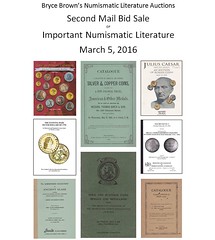 I'm pleased to announce that my Second Mail Bid Sale of numismatic literature is now available online for viewing and downloading at
http://www.bbnla.com/ .
I'm pleased to announce that my Second Mail Bid Sale of numismatic literature is now available online for viewing and downloading at
http://www.bbnla.com/ .
The sale will close on March 5, 2016 at 8:00 PM EST. Bids may be submitted via email, fax, mail, and phone.
Featuring the David Hirt collection of Edward Cogan auction catalogs and related ephemera, desirable 19th century and modern auction catalogs, numerous out-of-print United States and foreign reference texts, specialized consignments of Russian and Ancient coin auction catalogs, and one of the largest selections of shipwreck auction catalogs ever offered.
Notable items include:
- Seldom-offered Edward Cogan auction catalogs and addenda letters
- Two Christie’s 1950 sales of the George Mikhailovich Russian collection, one priced and named
- The catalog of the Reverend John Suchos collection of Polish coins
- The 1949 Christie’s sale of the Fitzwilliam collection of Roman Imperial coins, priced and named
- Bank Leu’s sale of the Nicolas collection of Roman Republican silver
- The rare Numismatic Fine Arts “Julius Caesar” auction of May 1991
- Stack’s Galleries 1952 sale of the Sobernheim collection
- A complete hardbound set of David Akers’ John Jay Pittman sale
- A large group of M.H. Bolender auction catalogs
- The deluxe hardcover edition set of Bowers & Merena’s Harry W. Bass, Jr. sales
- A reference collection of Sheridan Downey sales 1-34 and related publications
- Large paper Thomas Elder sale of the Henry C. Miller collection, ex Howard D. Gibbs
- Thick paper edition of Elder’s 196th sale
- Several Parke-Bernet consignor and bid-books
- A large number of rare Wayte Raymond publications
- A large and rarely-offered group of Stack’s catalogs from 1935-1959
- A number of scarce United States Coin Company auction catalogs
- Adams’ United States Numismatic Literature, Volumes 1 & 2
- A lovely and scarce Early United States Dimes 1796-1837
- A John Reich Journal Volume 1, Number 1, in gem new condition
- A Deluxe Full Leather edition of Kagin’s Private Gold Coins and Patterns of the United States
- A presentation edition of Martin Logies’ Flowing Hair Silver Dollars of 1794
- Ray Malone’s rare limited edition of Numismatic Auction Catalogues Relating to the Historical Coinages of Canada
- A large group of Coin Collector’s Journals, bound in Publishers Cloth
- Stack’s Numismatic Review, complete, 1943-1947
- Rarely-seen Harold Thomas bibliographies
- A large group of Reports of the Director of the U.S. Mint
- The extensive Landlubber Reference Collection of shipwreck auction catalogs
- Several “missing from Gengerke” auction catalogs
Bryce Brown's Numismatic Literature Auctions
P.O. Box 16
Avon, CT 06001-0016 USA
email: numismatics@att.net
Phone: 860-751-2555
Fax: 203-900-0249
www.BBNLA.com
LAKE BOOKS SALE #124 CLOSES MARCH 15, 2016
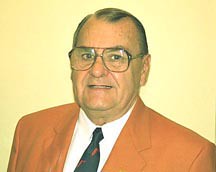 This is to give all of you a heads up as to my condition and explain what happened to me when I had my accident at the FUN show on January
7th. While driving a motorized scooter around the convention center, I managed to drive backwards over a four step stairwell and did a one and one
half back flip landing on my back with the scooter on top of me. This prompted a trip via ambulance to Tampa General Hospital and a three day
stay.
This is to give all of you a heads up as to my condition and explain what happened to me when I had my accident at the FUN show on January
7th. While driving a motorized scooter around the convention center, I managed to drive backwards over a four step stairwell and did a one and one
half back flip landing on my back with the scooter on top of me. This prompted a trip via ambulance to Tampa General Hospital and a three day
stay.
When I was taken home after that stay (by Convention Coordinator Cindy Wibker on the 10th), I was doing fine until some nerves that were injured decided to act up and cause a fall in my bathroom sending me to the hospital here in St. Petersburg. I am now home and will be glad to receive bids for our sale #124 which now has a closing date of March 15, 2016 at 5:00 PM EST.
In order to help me get bids entered more easily, I am asking that you do not wait until the last minute to send me your bids. I am not as speedy on the computer as I will be, so give me some help in this regard. Don’t forget, ties are won by the earliest bid received. I plan to have the catalog available for viewing on our web site by Feb. 9th at http://www.lakebooks.com/current.html
Many thanks for your help and your bids ahead of time. Good Luck with your bidding, Fred
Lake Books
6822 22nd Ave N
St. Petersburg, FL 33710-3918
727-343-8055 fax: 727-381-6822
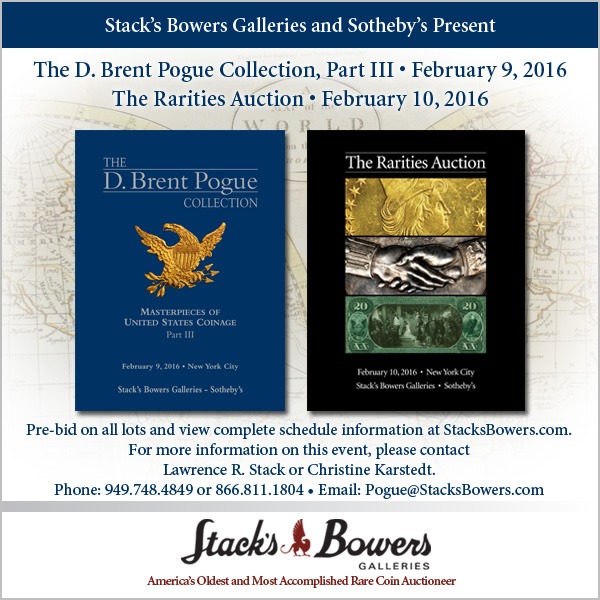
NEW BOOK: 1849: THE PHILADELPHIA MINT STRIKES GOLD
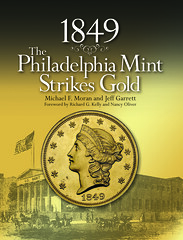 Whitman Publishing announces the release of 1849: The Philadelphia Mint Strikes Gold, by Michael F. Moran and Jeff Garrett. The
352-page hardcover book will be available in early March 2016 from booksellers and hobby shops nationwide, and online (including at www.Whitman.com),
for $49.95. It can also be borrowed for free as a benefit of membership in the American Numismatic Association, through the Dwight N. Manley
Numismatic Library.
Whitman Publishing announces the release of 1849: The Philadelphia Mint Strikes Gold, by Michael F. Moran and Jeff Garrett. The
352-page hardcover book will be available in early March 2016 from booksellers and hobby shops nationwide, and online (including at www.Whitman.com),
for $49.95. It can also be borrowed for free as a benefit of membership in the American Numismatic Association, through the Dwight N. Manley
Numismatic Library.
Award-winning researcher Michael Moran (author of Striking Change: The Great Artistic Collaboration of Theodore Roosevelt and Augustus Saint-Gaudens), joined by gold-coin specialist Jeff Garrett, chronicles the trials and tribulations of the U.S. Mint in the first half of the 19th century and the tremendous impact that the 1848 discovery of gold in California had upon that institution and the nation as a whole. From early struggles for adequate facilities in Philadelphia to dramatic political debates waged in Washington, D.C., the remarkable evolution of the Mint and the country’s coins and medals has never before been explored in such detail.
“The 1848 arrival of Colonel Mason’s oyster-can full of California gold in Washington would change everything in the United States,” Moran and Garrett write. “It would fuel a rapid industrialization across the Northern states with a supporting rail system. It would leave few institutions untouched, least of all the United States Mint at Philadelphia, which would be shaken to its very foundation and only just barely survive.”
1849: The Philadelphia Mint Strikes Gold includes hundreds of full-color images, some not seen in print for generations; an engaging narrative that sheds new light and draws fresh new conclusions; rich details on the colorful personalities involved and their interactions; and an inventory of the
Smithsonian’s gold holdings. Whitman publisher Dennis Tucker describes it as “a treasure for the coin collector, the gold investor, and everyone interested in the fascinating history of the United States.” Numismatic historians Richard G. Kelly and Nancy Oliver call it “a fascinating account of the trying period of the California Gold Rush and its effect on the United States. 1849: The Philadelphia Mint Strikes Gold comes with our highest recommendation. We were genuinely impressed with the depth of the research . . . written in the style of numismatic history at its best.”

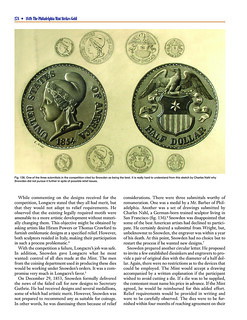
1849: The Philadelphia Mint Strikes Gold
By Michael F. Moran and Jeff Garrett;
foreword by Richard G. Kelly and Nancy Oliver
ISBN 0794842453
Hardcover, 8.5 x 11 inches
352 pages, full color
Retail $49.95 U.S.
For more information or to order, see:
1849: The Philadelphia Mint
Strikes Gold (www.whitman.com/store/Inventory/Detail/1849-The-Philadelphia-Mint-Strikes-Gold+0794842453)
NEW BOOK: 2015 U.S. MINT ANNUAL REPORT
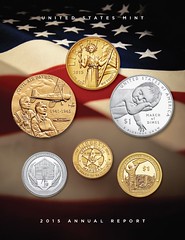 Established in 1792, the United States Mint (Mint) is the world’s largest coin manufacturer. Since Fiscal Year (FY) 1996, the Mint has
operated under the Public Enterprise Fund (PEF) (31 U.S.C. § 5136). The PEF enables the Mint to operate without an appropriation. We generate revenue
through the sale of circulating coins to the Federal Reserve Banks (FRB), numismatic products to the public, and bullion coins to authorized
purchasers. Revenue in excess of amounts required by the PEF is transferred to the United States Treasury General Fund.
Established in 1792, the United States Mint (Mint) is the world’s largest coin manufacturer. Since Fiscal Year (FY) 1996, the Mint has
operated under the Public Enterprise Fund (PEF) (31 U.S.C. § 5136). The PEF enables the Mint to operate without an appropriation. We generate revenue
through the sale of circulating coins to the Federal Reserve Banks (FRB), numismatic products to the public, and bullion coins to authorized
purchasers. Revenue in excess of amounts required by the PEF is transferred to the United States Treasury General Fund.
The Mint operates six facilities and employs approximately 1,600 employees across the United States. Each facility performs unique functions critical to our overall operations. Manufacturing facilities in Philadelphia and Denver produce coins of all denominations for circulation. Both facilities also produce dies for striking coins. All sculpting and engraving of coin and medal designs is performed in Philadelphia. Production of numismatic products, including bullion coins, is primarily performed at facilities in San Francisco and West Point. All four production facilities produce commemorative coins as authorized by federal laws. The United States Bullion Depository at Fort Knox stores and safeguards United States gold bullion reserves. Administrative and oversight functions are performed at our Headquarters in Washington, D.C.
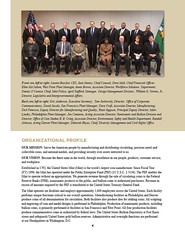
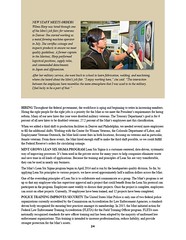
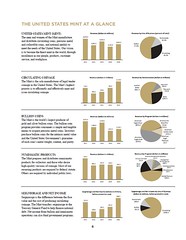
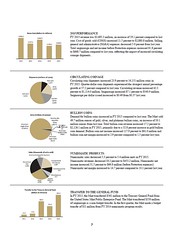
To read the U.S. Mint Reports from 2001 to 2015, see:
Annual Report
(http://www.usmint.gov/about_the_mint/?action=annual_report)

TAKE A BOW, COLONIAL COIN BOOK AUTHORS!

Five C4 authors photographed at the club’s Baltimore convention in November, 2015: (left to right) Mike Demling (“New Jersey Coppers” and “Massachusetts Coppers”; Chris McDowell (“Abel Buell”); Will Nipper (“In Yankee Doodle’s Pocket”); Tony Carlotto (“The Copper Coins of Vermont”); Syd Martin (“French Coinage Specifically for Colonial America”).
To read the earlier E-Sylum articles about these books, see:
NEW BOOK: NEW JERSEY COPPERS BY MICHAEL A. DEMLING
(www.coinbooks.org/esylum_v14n41a04.html)
NEW BOOK: ABEL BUELL AND THE CONNECTICUT AND FUGIO COINAGES
(www.coinbooks.org/esylum_v18n29a07.html)
BOOK REVIEW: IN YANKEE DOODLE.S POCKET BY WILL NIPPER
(www.coinbooks.org/esylum_v11n42a04.html)
NEW BOOK: FRENCH COINAGE SPECIFICALLY FOR COLONIAL AMERICA
(www.coinbooks.org/esylum_v18n51a05.html)
For more information about C4, see:
www.colonialcoins.org

NEWMAN NUMISMATIC PORTAL SCANS THE CLARION
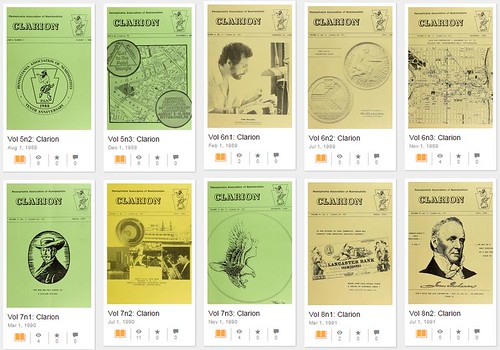
The Newman Portal has scanned a substantial run of The Clarion, the journal of the Pennsylvania Association of Numismatists. This particular group spans the period 1985-2006, and the Newman Portal will be filling out the remainder in the near future. While state publications tend to focus on show news, advertising, and social events, The Clarion has featured a steady stream of useful, original material. In particular, The Clarion leverages its proximity to the U.S. Mint, and, within its pages, we find interviews of Mint engravers such as Gilroy Roberts [image attached, from November 1990, vol. 7, no. 3] and Elizabeth Jones.
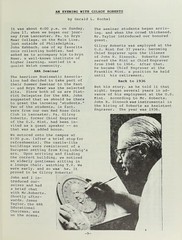 As with similar publications, personalities abound, and a quick survey identifies hobby figures such as Harry Forman, Frank Gasparro, and
John Eshbach, well-known in the bibliophilic realm as the collector of material related to Charles Steigerwalt, the 19th century Lancaster, PA
dealer. The Newman Portal wishes to thank Tom Uram, PAN President, and Pat McBride, PAN Treasurer, for facilitating presentation of this content on
the Newman Portal.
As with similar publications, personalities abound, and a quick survey identifies hobby figures such as Harry Forman, Frank Gasparro, and
John Eshbach, well-known in the bibliophilic realm as the collector of material related to Charles Steigerwalt, the 19th century Lancaster, PA
dealer. The Newman Portal wishes to thank Tom Uram, PAN President, and Pat McBride, PAN Treasurer, for facilitating presentation of this content on
the Newman Portal.
To read The Clarion on Internet Archive, see:
https://archive.org/details/newmannumismatic?and%5B%5D=clarion&sort=date
TO DIGITIZE OR NOT TO DIGITIZE
To digitize or not digitize, that is the question.
At the forefront of efforts to digitize printed numismatic works to subsequently make available free for numismatic research, are the American Numismatic Society and the Newman Numismatic Portal.
The Newman Numismatic Portal is an educational outreach initiative of the Eric P. Newman Numismatic Educational Society.
The ANS has been focused on digitizing references and other numismatic literature on ancient and world numismatic subjects along with auction catalogs to which researchers, collectors and others with interest would otherwise not have access.
The Newman Numismatic Portal is also digitizing major numismatic references that have been out-of-print for decades, auction catalogs, as well as periodicals of specialty collector clubs who have granted permission for digitization.
The subject of whether to digitize the printed word was broached during a January meeting of a specialty collector club. The question was raised about whether permission should be granted for carte-blanche digitization of all club publications, or if there should be any restrictions.
Opinions were also raised as to whether allowing digitization would affect club membership. Also posed was the effects digitization of original vintage numismatic references would have on the value of printed copies held by collectors. And some authors of numismatic works published in recent years wondered the effect digitization would have on their efforts to profit from their works or at the least, recoup their costs.
I reached out to two numismatic bibliophiles, Wayne Homren, and Len Augsburger, to weigh in with their opinions on the subject. Both work closely with the Newman Numismatic Portal. Wayne is also editor of The E-Sylum, the weekly electronic newsletter of the Numismatic Bibliomania Society. Augsburger is an NBS governor.
“I view digitization as a tool which enhances print,” says Augsburger. “Being able to search a large group of documents brings additional value to a physical library. It’s fine to have a complete run of The Numismatist, but unless you can search it some of the value is lost. In many cases you might search on something and then go retrieve the physical copy for easier access. For research purposes, physical copies are often easier to work with. One can flip through an auction catalog much faster than viewing individual lots online.”
Augsburger said he doesn’t view digitization as detrimental to printed copies. “The American Journal of Numismatics (first series, 1866-1924) has been online for years, and printed copies still trade actively. To use a more extreme example, a physical copy of the Gutenberg bible, or a Dunlap printing of the Declaration of Independence, remain extraordinarily valued documents, even though digital copies are available.”
Augsburger explains the Newman Numismatic Portal is working on a solution for text search of in-copyright documents.
NNP has also digitized back issues of collector club journals, including those of the Liberty Seated Collectors Club and NBS.
“Keeping current subscribers engaged is an understandable concern, so most organizations [will] hold back the last two to three years of issues from digitization,” Augsburger said. “Organizations need to have subscribers to produce content in the first place, so protecting the subscriber base is a completely reasonable concern.”
Homren said numismatic book dealer David Fanning related in a recent interview that references in top physical condition [or those with fine bindings or] author signatures or collector annotations will retain or increase their value despite digitization.
“Contemporary broadsides, pamphlets, catalogs and periodicals are a tangible link to numismatic history, and are often far more rare than the coins they describe. As more and more people recognize these as collectibles in themselves, demand and prices will increase.
“I think that in numismatic literature we will see a continuation of the general trend in used and rare books that started with the introduction of the Internet. Common stuff will stagnate or go down in price, but rare items will continue to rise. With greater availability of the information to researchers, there will be more references [to] and more publicity for the rare and interesting items, boosting interest and demand.”
Digitization of numismatic literature has assisted me tremendously in my research.
To digitize or not to digitize – What do YOU think?
To read the complete article, see:
TO DIGITIZE OR NOT TO DIGITIZE, THAT IS THE
QUESTION (www.coinworld.com/voices/paul-gilkes/2016/02/to_digitize_or_nott.html)
To read the earlier E-Sylum article, see:
ARTICLE PROFILES LITERATURE DEALER DAVID FANNING
(www.coinbooks.org/esylum_v19n03a06.html)
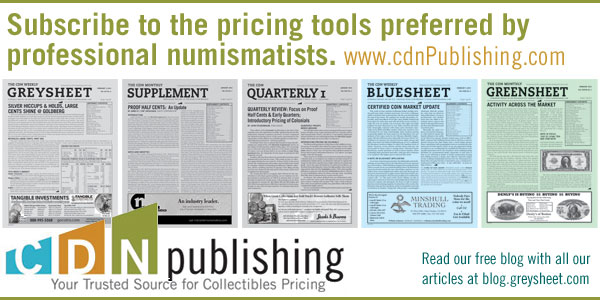
COL. BILL MURRAY 1920-2015
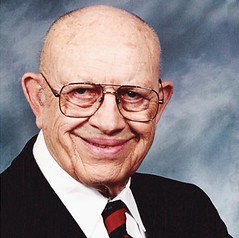 Retired Coin World columnist Col. William Bain Murray, 96, has died.
Retired Coin World columnist Col. William Bain Murray, 96, has died.
Murray died Nov. 16, 2015, three days after his 96th birthday.
Murray authored a column for Coin World from March of 1976 until filing his final column on his 90th birthday, Nov. 13, 2010.
The column originally was titled “The New-Mismatist,” but in 1993 was changed to “The New Collector.”
Col. Murray had written a column for Numismatic Scrapbook magazine since the June 1974 issue and then in Coin World starting in March 1976 after the monthly Numismatic Scrapbook was folded into the pages of Coin World.
Col. Murray was an advocate for new collectors, whether they were young or adult, just as long as they were beginning their hobby journey. He was the 1996 recipient of the Clemy Award, the highest honor of the Numismatic Literary Guild.
Born in Harvard, Ill., he lived in Laguna Beach, Calif., before starting his military career. He served in the Pacific Theater during World War II and retired from the Army in 1972.
He is survived by his wife, Jeanne Hershey Murray; son Bill and daughter-in-law Charlotte Murray; daughter Mary and son-in-law Ed Shugert; daughter Donna Covey; and several grandchildren.
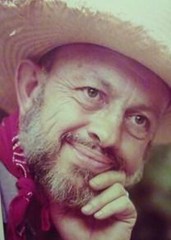 I visited Bill and his wife at their lovely military retirement home in San Antonio while on a business trip there in the early 2000s. He
had a nice numismatic library and was still publishing his column, where he often reviewed or recommended numismatic books to collectors. He was a
longtime member of the Numismatic Bibliomania Society. A true gentleman, he will be missed. Pete Smith provided this more whimsical portrait of a
younger Bill Murray from his online obituary. Thanks! -Editor
I visited Bill and his wife at their lovely military retirement home in San Antonio while on a business trip there in the early 2000s. He
had a nice numismatic library and was still publishing his column, where he often reviewed or recommended numismatic books to collectors. He was a
longtime member of the Numismatic Bibliomania Society. A true gentleman, he will be missed. Pete Smith provided this more whimsical portrait of a
younger Bill Murray from his online obituary. Thanks! -Editor
To read the complete article, see:
Former Coin World columnist Bill
Murray dies (www.coinworld.com/news/us-coins/2016/02/former-coin-world-columnist-bill-murray-dies.html)
To read the online obituary, see:
Col. William Bain Murray II, US Army, Retired
(http://obits.dignitymemorial.com/dignity-memorial/obituary.aspx?n=William-Murray+II%2c+US+Army%2c+Retired&lc=7474&pid=176543499&mid=6679018)
DAVID J. GINSBURG, 1958-2016
Ray Williams writes:
 Hearing of Dave's passing was just so shocking. So unexpected. He had some back surgery a few months ago and seemed to have been in
good health afterwards. I drove up to Bloomfield NJ Friday afternoon with Harry Garrison and Bill Liatys to attend the visitation at O'Boyle
Funeral home. We gave our condolences to Betsy (Dave's wife) and the rest of the family, letting them know of the many, many friends Dave had in
the hobby.
Hearing of Dave's passing was just so shocking. So unexpected. He had some back surgery a few months ago and seemed to have been in
good health afterwards. I drove up to Bloomfield NJ Friday afternoon with Harry Garrison and Bill Liatys to attend the visitation at O'Boyle
Funeral home. We gave our condolences to Betsy (Dave's wife) and the rest of the family, letting them know of the many, many friends Dave had in
the hobby.
She had emailed me the afternoon of Dave's passing, letting me know he died of a heart attack that morning. The day before, we were emailing about last Sunday's E-Sylum, where a headline referred to me as a Numismatic Supermodel. Dave sent a link to the E-Sylum to the NJNS members. I emailed him saying that even at my best in my youth, I was average at best, and no supermodel. His last email to me said, "At least you're tall enough to be a supermodel!".
Dave was past president and current secretary of the New Jersey Numismatic Society. I've been VP of the NJNS for a while now, and I was secretary as Dave was president. Dave loved early paper money and fiscal documents. His knowledge of history as it pertained to numismatics was excellent. He always had a smile on his face and freely shared knowledge. I will miss him terribly.
Michael S. Fey writes:
I attended funeral services for him Friday. We, at the New Jersey Numismatic Society, are all in shock at the news of Dave's passing. Dave was a past recipient of our Nettleship Award, the highest honor bestowed upon a member of our Society. He will be remembered for his service as Past President and Secretary, for his many presentations of scholarly numismatic research, and for being a genuinely nice human being. May he rest in peace knowing that his fellow collectors thought so highly of him.
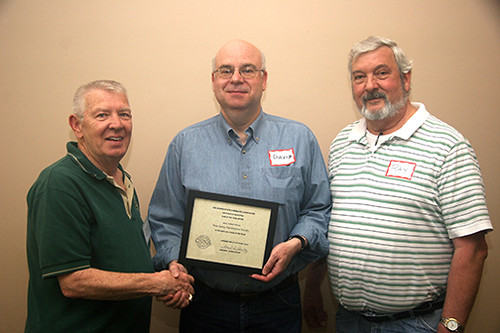
David Bailey, David Ginsburg, Ray Williams
Ray provided this photo. He adds:
The Garden State Numismatic Association (GSNA) presented its club of the year award to the New Jersey Numismatic Society. Receiving the award on behalf of the NJNS is Dave Ginsburg, Past President of the society.
David Gladfelter adds these notes:
David had an interest in practically all things numismatic. I last saw him a few months ago when he invited me to speak to NJNS. The occasion was well attended and a good time was had by all. A shock to lose him so suddenly.
Others who knew him well were Dave Bailey, current president of both the Garden State Numismatic Association and the New Jersey Numismatic Society (a member club of GSNA); Ray Williams, former vice president of GSNA and active in many numismatic organizations, including Colonial Coin Collectors Club and Trenton Numismatic Club (past president of both), and Harry Garrison, former chairman of the annual GSNA convention and operator of Colonial Valley Coins in Hamilton Township, a Trenton suburb.
Charles Nettleship was a founding member of NJNS in the 1930s who remained active in it for at least 35 years, The award that was established in his name recognizes hobby contributions of NJNS members.
Roger Burdette writes:
In the passing of David Ginsburg, the hobby has lost a "quiet contributor" to numismatic and American historical knowledge. He had a deep interest in southern gold and how the economy operated in the 19th century. He had recently completed an article, “Full Value for Your Money – Two Major Concerns about Gold Coins in the 1870s,” that was going to be sent to The Numismatist. Dave contributed to several books and had a great store of knowledge. His messages on NGC and PCGS message boards were insightful and filled with astute observations.
Doug Winter writes:
This is really tragic. Dave was a great numismatic scholar and a truly nice guy who I was lucky to get to know. I'm greatly saddened by this news.
Ron Thompson writes:
I have been a longtime member of the New Jersey Numismatic Society, joining in the early 1990s. David Ginsburg joined after me. The NJNS has had a number of distinguished numismatists as members since its founding in 1933. Many are published.
David was mostly a collector and researcher but he did contribute frequently to The E-Sylum and he certainly shared his knowledge in presentations at the NJNS. He gave generously of his time to organizational matters of the NJNS, mostly as Secretary but also as President.
Coin World had an article about him five years ago when he was selected to receive the Charles F. Nettleship Award for service to the society. Only former Nettleship Award recipients select new awardees and then only when the service level to the society is significant. David was a stalwart in the NJNS. He appeared in good health so his passing was unexpected. He will be truly missed. Below is a listing of former Nettleship Award recipients through 2013.
Awardee - Date - Member # - Notes 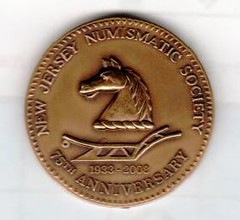
1. Herbert Oechsner 1983 Deceased 1984?
12. Robert Schonwalter 1984 155 (H-6) Member: 1961. Deceased 1998
13. Ernest Keusch 1985 191 (H-5) Deceased 2001
14. James Heath 1986 206
15. Harold Flartey 1987 210 (H-2) Deceased 2002
16. Harry Resigno 1988 207
17. Herbert Silberman 1989 180 (H-4) Deceased 199?
18. Charles Davis 1991 253
19. Spencer Peck 1992 251
110. Arno Safran 1994 247
111. Chris Connell 1995 267 Deceased 2007
112. Steve Middleton 1996 275 Deceased 2009
113. Malcolm Heckman 1997 222
114. Ray Williams 1999 283
115. Ernest Keusch 2000 191 (H-5) Pour Merite. Deceased 2001
116. David Lange 2001 302
117. Ron Thompson 2004 288
118. Michael Fey 2007 293
119. Arnold Miniman 2010-2011 #316
120. David Ginsberg 2011-2012 #341
121. Carl Feldman 2012-2013 #266
To read the complete message board, see:
David J. Ginsburg passes
(http://boards.collectors-society.com/ubbthreads.php?ubb=showflat&Number=9144774#Post9144774)
David J. Ginsburg, Age 57, of Glen Ridge, NJ, passed away unexpectedly on February 3, 2016. Beloved husband of Elisabeth and devoted father of Katherine. Loving brother of Sharon Lesgold and Rachel Ginsburg.
Born August 22, 1958 in Kingman, Arizona, son of Benjamin and Esther Ginsburg. Earned a BA from Northwestern University and MBA from the University of Missouri. Served as an officer in the U.S. Air Force from 1980-1985.
Resident of Glen Ridge for the past 26 years. Trustee of the Glen Ridge Library Board, Secretary and Past President of the NJ Numismatic Society and winner of its Nettleship Award for numismatic accomplishment.
To read the complete obituary, see:
David J. Ginsburg
(http://obit.funeralnet.com/obitdisplay.html?id=1586943&clientid=oboylefuneralhome&name=)
To read the earlier E-Sylum articles, see:
RESEARCHERS WELCOME THE NUMISMATIST DIGITAL ARCHIVE
(www.coinbooks.org/esylum_v18n49a08.html)
NOTES FROM E-SYLUM READERS: JANUARY 31, 2016 : Ray Williams, Numismatic
Supermodel (www.coinbooks.org/esylum_v19n05a15.html)
THE BOOK BAZARRE
REGARDING THE U.S. MINT RETIREMENT MEDAL
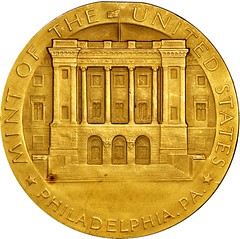
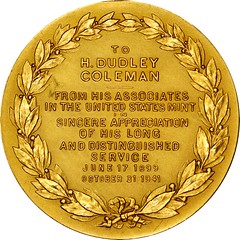
The description on the Stack’s website refers to H. Dudley Coleman, who, among many other accomplishments, was Melter & Refiner of the New Orleans Mint from 1899 to 1905 and member of the Assay Commission in 1912. He died in 1926.
As the description mentions, the Medal shows service from 1899 to 1941 and is actually for H. Dudley Coleman, who was usually referred to as “Hubert D. Coleman” and was, I believe, the son of H. Dudley Coleman.
When H. Dudley Coleman was appointed Melter & Refiner of the New Orleans Mint, he hired Hubert D. Coleman as Weigh Clerk. Hubert D. Coleman worked in the M&R Department of the New Orleans Mint until early 1905, when President T.R. Roosevelt appointed him to be Melter & Refiner, replacing his father. (He was nominated as Hubert D. Coleman, Jr.) He served as Melter & Refiner until the New Orleans Mint was closed for coinage, when he was hired as assistant melter & refiner of the Philadelphia Mint.
There is a notation in the Mint Annual Report for the FYE June 30, 1911: “During the year Mr. Hubert D. Coleman, formerly melter and refiner of the New Orleans Mint, now closed to coinage operations, was appointed assistant melter and refiner of this institution [the Philadelphia Mint] and entered upon his duties November 4, 1910.”
Unfortunately, the Official Register of Government Officers stopped listing all or most of the employees of the Mints after 1905, so I can’t track his career. However, I have seen some Census reports that show Hubert D. Coleman as a resident of Philadelphia in the 1920s.
By the way, about a year or so ago, noted numismatic researcher Roger Burdette mentioned to me that these retirement medals were usually gold plated and an actual gold medal would have had to have been specifically authorized by the Secretary of the Treasury, and, therefore, a copy of the authorization should exist in the National Archives.
To read the entry in the Biographical Directory of the United States Congress for Hamilton Dudley Coleman, see: http://bioguide.congress.gov/scripts/biodisplay.pl?index=C000619
Unfortunately, I have no idea why Hubert D. Coleman was referred to as “junior”, when his (presumed) father was Hamilton Dudley Coleman. The elder Coleman was nominated by President McKinley as “H. Dudley Coleman” and I haven’t yet found an obituary for either Coleman to confirm the relationship.
To read the earlier E-Sylum article, see:
SELECTIONS FROM THE STACKS-BOWERS FEBRUARY 2016 RARITIES SALE : Lot 70: U.S. Mint
Retirement Medal (www.coinbooks.org/esylum_v19n05a28.html)
WHERE ALL THE SHIELD NICKELS WENT
In his business newsletter Making the Grade #25, Dave Wunck of Dave Wnuck Numismatics LLC, muses about the paltry numbers of U.S. coins that have survived to the present. He wonders where they went – especially coins made from non-precious metals. He continues:
So let's pick a coin struck [in] a metal where there was no significant melting: nickel. I know of no one who has melted quantities of nickel coins to turn them into nickel alloy ingots for speculation or investment, for example.
And then let’s pick a design: the Shield nickels made from 1866 through 1883.
There were 128 million shield nickels minted. Do even 5% of these survive? If so, that still means that several million shield nickels are still lying around somewhere.
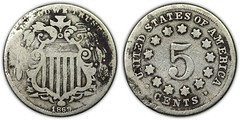 Although it's not obvious, there actually was one place that melted large quantities of shield nickels – the U.S. Mint. One of the
functions of the mints was to remove worn, damaged and mutilated coins from circulation. These came to the mints in bags and barrels from banks,
sub-Treasuries and later, Federal Reserve Banks. Almost anything that resembled a U.S. coin but was not acceptable in circulation found its way to
the mints and from there to the melting crucibles.
Although it's not obvious, there actually was one place that melted large quantities of shield nickels – the U.S. Mint. One of the
functions of the mints was to remove worn, damaged and mutilated coins from circulation. These came to the mints in bags and barrels from banks,
sub-Treasuries and later, Federal Reserve Banks. Almost anything that resembled a U.S. coin but was not acceptable in circulation found its way to
the mints and from there to the melting crucibles.
Over time, as new coins replaced old, and old coins became badly worn, the remains were melted by the ton. This recovered metal was used in the next generation of Liberty, or Buffalo or Jefferson nickels. (The same applied to all coin denominations.)
So, next time you come across a dateless Buffalo nickel remember that its metal might once have been part of a shiny new shield nickel, anxious to delight a child’s sweet tooth.
Roger adds:
Maybe someone will take up the task of collecting the recoinage information. I suspect the cumulative quantities will surprise many.
To read the complete discussion, see:
Dave Wnuck muses about the survival
of U.S. coins. (http://boards.collectors-society.com/ubbthreads.php?ubb=showflat&Number=9129294#Post9129294)
To read the earlier E-Sylum article, see:
WHERE HAVE ALL THE SHIELD NICKELS GONE?
(www.coinbooks.org/esylum_v19n05a17.html)
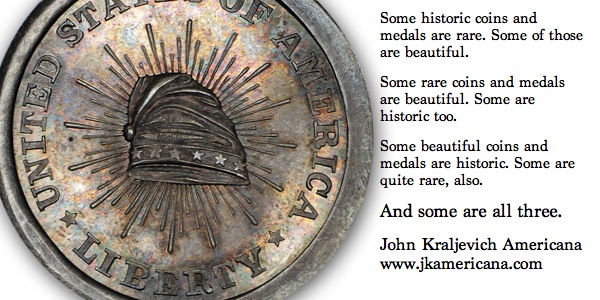
NOTES FROM E-SYLUM READERS: FEBRUARY 7, 2016
G. G. Wilkins Counterstamps
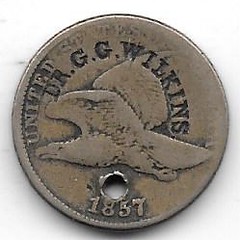

Tom Casper writes:
In the January issue of The Numismatist I read with interest the article "Revisiting Doctor Wilkins". It piqued my interest because one of his counterstamps resides in my collection. The article referenced a book that was written about him. I searched the internet and located a used copy which I purchased. The book was written in 1987 by Q. David Bowers. A check of the contributors to the book showed one of them is the esteemed Wayne K. Homren. I was unaware a book has been published about this prolific counterstamper, Dentist George G. Wilkins of Pittsfield, NH. Quoting from the Numismatist article, "Brunk might have stamped more than 100,000 coins based on their survival rate". So the piece is very common but one with an interesting story. Shown is my piece counterstamped on an 1857 Flying Eagle cent.
The 1964 Michael Caine film 'Zulu'
Last week I wrote:
I'm not familiar with the 1964 Michael Caine film mentioned in this article, which plays up the connection to illustrate the historical importance of a rare South Africa medal coming up for sale soon.
Chip Howell writes:
Seriously!? I wonder how you managed not to see "Zulu" at one time or another--it got shown a lot on TBS, for example. It's Caine's first starring role, and a personal favorite of mine.
Eric Schena writes:
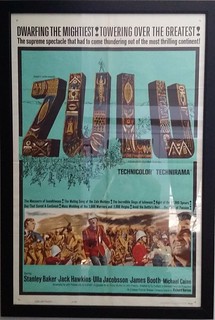 Zulu is a fantastic film and one of my favorite films about the various British colonial wars of the Victorian era. While
historically flawed in many respects - most notably with the representation of Pvt. Henry Hook, VC as a malingerer and alcoholic when he was actually
a model soldier - it's a great actioner and a classic war film. The defense of Rorke's Drift produced no less than 11 Victoria Cross winners,
the most ever awarded for a single action, as well as four Distinguished Conduct Medals. It's one heck of a fascinating story, one which prompts
those of us who are so inclined to delve deeper into "Victoria's little wars."
Zulu is a fantastic film and one of my favorite films about the various British colonial wars of the Victorian era. While
historically flawed in many respects - most notably with the representation of Pvt. Henry Hook, VC as a malingerer and alcoholic when he was actually
a model soldier - it's a great actioner and a classic war film. The defense of Rorke's Drift produced no less than 11 Victoria Cross winners,
the most ever awarded for a single action, as well as four Distinguished Conduct Medals. It's one heck of a fascinating story, one which prompts
those of us who are so inclined to delve deeper into "Victoria's little wars."
Once you see Zulu, you should also check out the later prequel, Zulu Dawn, which tells the story of the Battle of Isandlwana which occurred just prior and is referenced in Zulu. While significantly more accurate and shot with a much bigger budget, it did not do well at the box office when it came out on the 100th anniversary of the battle. There was also an episode of PBS' Secrets of the Dead that explored the Isandlwana battlefield and clarified many of the enduring mysteries of that battle.
The battle was a decisive and absolute Zulu victory: of the 1,700 strong British forces engaged, 1,300 died. I am not surprised that South Africa Medal has such a high estimate - medals named to confirmed participants are among the most sought after of the Victorian era campaign medals. For now, I'll have to content myself with a one-sheet for Zulu framed and hanging in the house (here's a photo of the poster, albeit not a great one).
To read the earlier E-Sylum article, see:
THE SOUTH AFRICA MEDAL (www.coinbooks.org/esylum_v19n05a29.html)
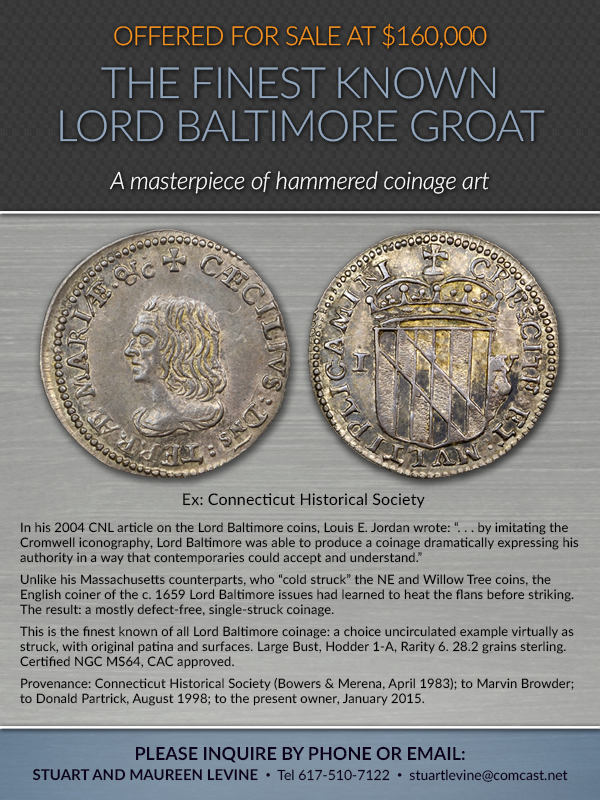
ISAAC FRANCIS WOOD (1841-1895)
Isaac Francis Wood (1841-1895), born on Thursday, July 15, 1841, in the old 7th Ward of New York City, then called the Quaker Ward, the son of Dr. Isaac Wood, M.D. (1793-1868), and his third wife Margaret Morell Hicks (1798-1873), the widow of Harvey Street. He was christened Francis Augustus Napoleon Wood. Later in life he changed his name twice: first, to Francis Augustus Wood, and second, in 1868, upon the death of his father and in his honor, as Isaac Francis Wood.
His father was the founder of the New York Institution for the Blind, and his third wife Margaret Morrell Hicks Wood. He is a direct descendent of Joseph Wood of Gloucestershire, England. His paternal grandfather was Samuel Wood of Oyster Bay, Long Island, New York. His maternal grandfather was John Hicks of Hempstead, Long Island, New York. In their day the Hicks, Wooley, Seerings and Wood families were the most prominent on Long Island.
He entered Haverford College at age 15 years in 1856. He was the founder of the Haverford Alumni Prize Medal for Oratory and Composition. He was the Vice-president of the Loganian Society. He was one of the founders of the Everett Society, and Vice-president of the Alumni Association (1877) and president (1878). He graduated B. A. 1862.
He worked for William Wood & Company the leading publisher in the city and was made a partner in the firm in 1868. He retired in 1871. However he continued in the publishing industry associated with J. H. Vail, Medical Publishers, Booksellers and Importers, successors to the Jobbing and Retail Department of William Wood & Co., to at least Spring of 1884.
In order to give him perspective in American numismatic history Samuel Hudson Chapman was born on Wood's 16th birthday. Wood is an illustrious figure born immediately after the very end of Post-Revolutionary War America 1800-1840, and the very beginning of Antebellum America. Coin auction sales had become common for two decades prior to his birth.
Collecting coins and studying numismatics were subjects that certainly were salient at Haverford College and most probably when he began interest in coins and medals. His interest in finding fellow associates to collect with led him to be one of the revivers of the American Numismatic and Archaeological Society (ANS) in 1864. He joined the American Numismatic and Archaeological Society on February 5, 1864 at the age of 22, and later became a Life Member.
In April 1864 he wrote to Henry Champion of the New Haven Numismatic Society regarding the catalogue of the Yale College Collection. Champion replied he never heard of the ANS, which led him to look into the matter of its incorporation. He spearheaded the nine incorporators of the American Numismatic and Archaeological Society on May 16, 1865. About this time he also spread the circular of the ANS for the Abraham Lincoln Medal soliciting through the mail its sale at $5 each and 20 % discount to any agent obtaining subscriptions.
He was one of five members appointed to a committee in March 1866 to found a journal for the society, which became the American Journal of Numismatics. He served as the ANS Librarian from 1869 to 1879.
There are numerous pieces of mail between Wood and the Chapmans in the Lupia Numismatic Library, Special Collection, The Chapman Family Archive, sufficient enough to produce a book about him and their transactions.
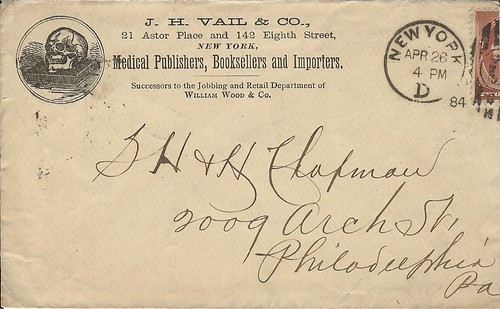
To read the complete article, see:
WOOD, ISAAC
FRANCIS (https://sites.google.com/site/numismaticmallcom/encyclopedic-dictionary-of-numismatic-biographies/wood-isaac-francis)
ARTICLE INTERVIEWS AUTHOR ANTHONY SWIATEK
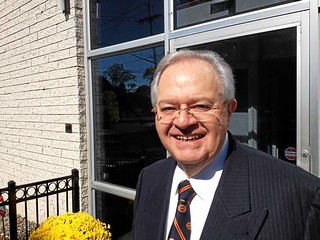
Anthony Swiatek: Owner of Minerva Coin & Jewelry Ltd. in Saratoga Springs
Why was the Surrender at Saratoga chosen to represent New York state for the U.S. Mint’s “America the Beautiful” quarters program?
In my opinion, it was a no-brainer. The 1777 Battles of Saratoga were the turning point of the American Revolution. Burgoyne’s Surrender marked the beginning of the end for the British. The Americans defeated a major a British army and forced them to lay down their arms. This opened the avenues for essential foreign recognition, primarily from France, whose support greatly contributed to America’s winning the war.
Where can the public obtain Saratoga quarters?
They were first offered to the public at face value (two roll limit) at the U.S. Mint’s coin launching ceremony held at Schuylerville High School on Nov. 17, 2015. The Glens Falls National Bank & Trust Company and Saratoga National Bank & Trust Company handled the initial distribution of Saratoga quarters. They are available at these banks and at Adirondack Bank & Trust Company. Most other banks have them, too.
Will these Saratoga quarters be valuable in the future?
Some people who bought these 25-cent rolls at face value ($10) on launch day (Nov. 17, 2015) immediately tried to sell them on eBay for $20. Some people sold to buyers who simply wanted to possess the issue or collectors who had to acquire them on or shortly after launch day. New York’s “Surrender at Saratoga” quarter is the 30th one in the series, which began in 2010. Rolls of quarters depicting other states ($10 face value) are being sold to collectors for anywhere from $11 to $14. So there is no great demand.
However, I believe the Saratoga quarter could end up being more valuable than the others in the future. We have the history of Saratoga’s locale, the popularity of our wonderful city and the famous summer racing season. It would be a good idea for local businesses here to obtain rolls now and hold onto them for summer time use. Collectors want sealed rolls. So in time, sealed rolls could be worth $25-$35 each.
What do the tiny initials “BF” and “RG” on the coin stand for?
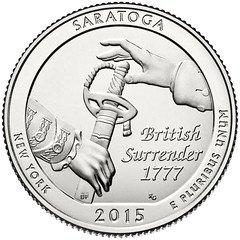 Barbara Fox drew and designed this coin’s reverse. Renata Gordon is a U.S. Mint sculptor – engraver. She created the model used to make the
eventual coin dies from Barbara Fox’s chosen drawing. Thus the creators’ initials appear on the coin. The design depicts General Burgoyne
surrendering his sword to General Gates.
Barbara Fox drew and designed this coin’s reverse. Renata Gordon is a U.S. Mint sculptor – engraver. She created the model used to make the
eventual coin dies from Barbara Fox’s chosen drawing. Thus the creators’ initials appear on the coin. The design depicts General Burgoyne
surrendering his sword to General Gates.
To read the complete article, see:
Five questions for Anthony Swiatek
(www.saratogian.com/lifestyle/20160131/five-questions-for-anthony-swiatek)
To read the earlier E-Sylum article, see:
COIN TELEMARKETING PIONEER STANLEY APFELBAUM : The Swiatek-Breen Commemorative
Book (www.coinbooks.org/esylum_v19n03a19.html)
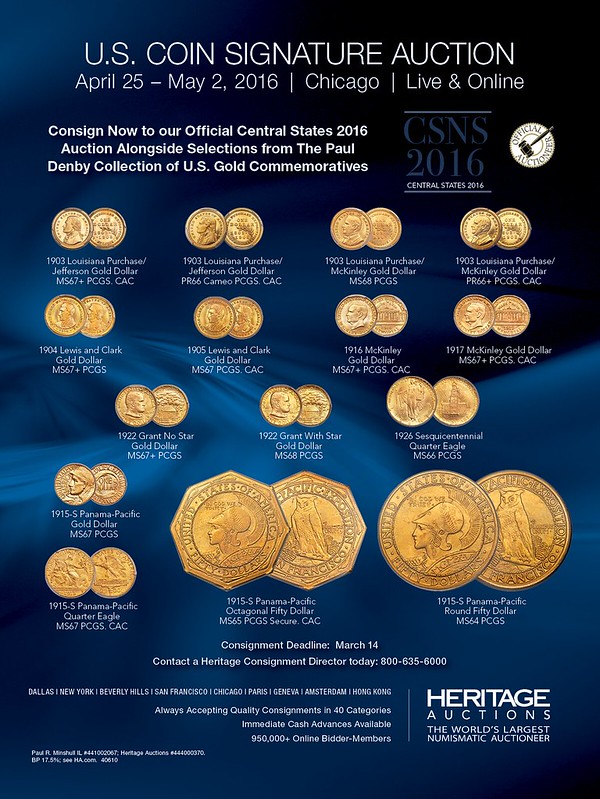
COIN DEALER B. MAX MEHL
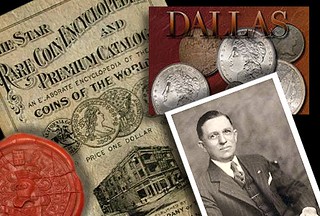 Benjamin Maximillian Mehl was born in Lodz, Russia (now Poland), on November 5, 1884. He came to America in April 1895 with his parents,
three brothers and a sister. As a young man he worked as a shoe clerk before entering the coin business. His first ad ran in The Numismatist
in December of 1903.
Benjamin Maximillian Mehl was born in Lodz, Russia (now Poland), on November 5, 1884. He came to America in April 1895 with his parents,
three brothers and a sister. As a young man he worked as a shoe clerk before entering the coin business. His first ad ran in The Numismatist
in December of 1903.
In February of 1904 Mehl placed a full-page ad in The Numismatist. Near the top it stated, “I beg to offer, subject to be unsold, the following Choice Coins.” Near the bottom, “Send 25c for my HUB COIN BOOB.”
At this time dealers could buy The Hub Coin Book from the publisher, Alexander and Co, and imprint their dealer name and address on the cover. Mehl sold copies of the book and sent them out to promote his business.
Mehl spent $12.50 to place an ad in Colliers Magazine in 1906. With this, his advertising branched out into the popular media. This continued to prove to be a successful advertising strategy.
In 1906 Mehl offered his Star Coin Book for a dime. This was inspired and heavily copied from the Hub Coin Book.
Mehl is credited with popularizing the hobby, once dominated by more wealthy collectors. People began to search their change hoping to find “a fortune in your pocket.” Streetcars were delayed while the conductors examined nickels presented for the fare.
By 1916, Mehl was successful enough to construct a building for his offices. He hired architect Wiley Clarkson to design the building at 1204 Magnolia Avenue. It had commercial space on the ground floor with apartments on the second and third floors. Above the doorway was the image of a Fugio Cent in cast stone. Long after his business closed, the building became vacant and fell into disrepair. It was saved from demolition, remodeled and repaired, and remains in Fort Worth today.
During the Depression Mehl advertised “Will pay $50 for a nickel of 1913 with Liberty Head, not Buffalo.” Only five 1913 Liberty Nickels were struck and they lacked Mint authorization. Mehl knew they were in strong hands and none would be offered. His intention was to make money by selling coin books instead of buying 1913 nickels.
Mehl died on September 28, 1957. Mary Ellen Ferguson carried on the Mehl business until her death in 1961. She had served as Mehl’s executive secretary for more than 40 years.
To read the complete article, see:
Numismatic History – Coin Dealer B. Max Mehl – A Texas
Master of Coins (www.coinweek.com/education/b-max-mehl-a-texas-master-of-coins/)
SOMMERS ISLAND SHILLING JEWELRY
Inspired by our discussion of the Dickeson copy of the Sommers Island Shilling, Philip Mernick writes:
these are pictures of two items from my brother Harry’s collection of coin jewellery. They are made of silver but as you can see from the bar brooch the design is taken from a book illustration of a copper coin. I have the distinct recollection that it is taken from the Catalogue of the Pembroke Collection, 1746.
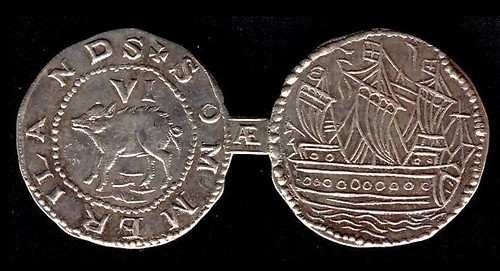
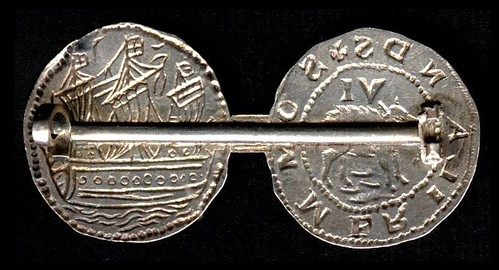
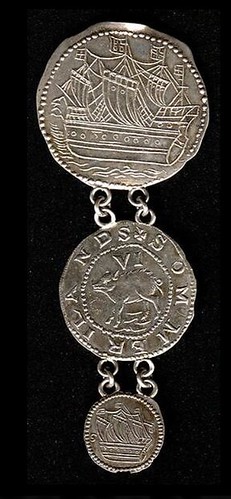
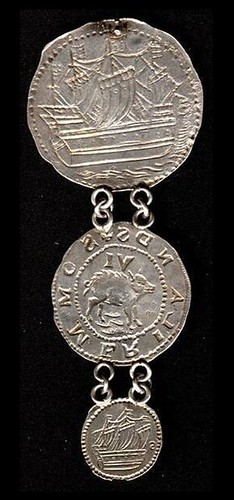
To read the earlier E-Sylum article, see:
THE DICKESON COPY OF THE SOMMERS ISLAND SHILLING
(www.coinbooks.org/esylum_v19n05a13.html)
THE BOOK BAZARRE
CONNECTICUT ARTISAN CRAFTS JEWELRY FROM COINS
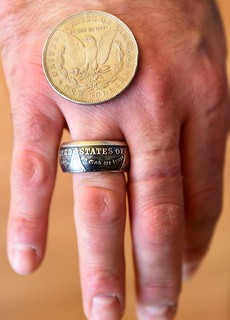 These unique wedding rings might have once been someone’s loose change jingling in their pocket.
These unique wedding rings might have once been someone’s loose change jingling in their pocket.
But that is immaterial to David Landino who meticulously cuts, hammers, files and heats each coin to create one-of-a-kind heirloom rings.
Whether it’s change that has been in circulation or coinage that holds more value, such as a U.S. Sterling Silver Morgan Dollar, each ring is unique and made to very exact specifications.
The company slogan is “Coins from generations past, rings for generations to come.”
And, Landino is prepared to create the next heirloom from possibly a collector’s item. His tool box includes a jeweler’s saw, leather and nylon hammers, steel ring sizing mandrel, ring stretcher, sandpaper and a blow torch.
“The difference in patinas here is that date’s (facing) out,” Landino explains holding a Morgan silver dollar ring, ordered from his company, D.L. Heritage Coin Rings & Handmade Jewelry, for a wedding in Jamaica this month. “The date is showing.”
Whether the date is visible while sitting on a finger or “In God We Trust. The United States of America” is showing on the ring, the inside displays the opposite side of the coin.
“I keep the detail on the obverse and reverse, is what the official terms of the coins are,” he explains. “They’re crisp throughout, so you don’t lose any of the detail. It just depends on what you want to see mostly.”
“He’s so meticulous about his work,” says Guilford resident Mary Amter. “It has to be perfect if he’s giving it to someone.”
“Really for me, it is about the value of the coin, but more so it’s about ‘this coin from 1909, who else could have held that coin in their hand at that time?’ For me that makes it a big deal,” he explained while turning an antique 1909 coin ring in his hand.
Now at 43 years old, Landino’s personal collection consists of 1700 and 1800 U.S. large cents, American pennies, dating back to when coins were minted at 1 1/8 inches diameter.
He got the idea for D.L. Heritage Coin Rings after he lost his ring on Palm Sunday 2013.
Upon finding out the cost of a replacement Landino decided that making a ring would be much less expensive. He began by making “a tapped ring.”
“You take a silver coin and you tap the outer rim with a spoon. The more you do it the more it starts to cave in on itself. Then you bore a hold in the center and you keep doing it, and you keep doing it.” Landino notes this work is repetitive, but relaxing.
“It was something that the troops used to do in WWI, WWII to combat boredom when they had nothing to do.”
While the ring Landino wears on his left hand is now a brand new wedding band, he has continued making rings, albeit more sophisticated than his first attempt.
The majority of the rings are made for a special occasions, including an anniversary, birthday, wedding or birth of a child. He has sold them worldwide, as far away as England and Australia, and all over the U.S.
“It’s always something that means something to someone,” says Landino. “It’s always, ‘I want my birth year, I want my mother’s birth year’ - and the stories that go along with them are just as cool as the rings themselves.”
The ring that will encircle the groom’s left hand in Jamaica was made from a Morgan silver dollar from the best man’s grandfather’s collection. Special indeed.
To read the complete article, see:
Worth it’s weight in gold
and silver: Clinton man takes old coins and makes heirloom rings by hand
(www.shorelinetimes.com/articles/2016/02/02/life/doc56b0f6bf3e9e6125072085.txt?viewmode=fullstory)
ARTIST PAOLO CURCIO'S COIN SKULL CARVINGS
 Artist Paolo Curcio had some of his coin carvings featured in a book called Skullture. Paolo reported that the book is by Vetro
Editions and is published in Italy. Although when checking on Amazon, the same book is shown to be by Ginko Press and in another listing it shows
Luca Bendandi and Paz Dizman as the authors. Possibly it has had more than one printing run which would explain the varying information. Or better
yet, maybe it was translated to another language and reprinted in another country just after release.
Artist Paolo Curcio had some of his coin carvings featured in a book called Skullture. Paolo reported that the book is by Vetro
Editions and is published in Italy. Although when checking on Amazon, the same book is shown to be by Ginko Press and in another listing it shows
Luca Bendandi and Paz Dizman as the authors. Possibly it has had more than one printing run which would explain the varying information. Or better
yet, maybe it was translated to another language and reprinted in another country just after release.
Coincidentally Paolo is originally from Italy but resides in northern Spain now. Paolo has traveled to the United States on two different occasions to attend the FUN show in Florida. The Original Hobo Nickel Society holds its annual meeting there and sets up a bourse table at that show which includes demonstrations on hobo nickel carving.
Paolo is one of several modern hobo nickel artists that embraces skull themes in his carvings. I actually theorized a year or two ago that hobo nickels with skull, skeleton, and zombie themes would give the hobo nickel craft mass exposure outside of numismatic audiences just because those themes are popular with much of the youth these days. These skull carvings have received mixed reviews among hobo nickel/numismatic collectors. While some collectors embrace them, there are other more traditional collectors who favor the basic portraits and people in derby hats. And then there are still others, possibly older generation types, who are not necessarily skull fans but can't help but collect some based on the skill and quality of execution.
To read the Facebook post, see:
Some of my
Carvings was featured in the book "Skullture" by Vetro Editions (www.facebook.com/groups/theoriginalhobonickelsociety/
permalink/802103876561808/?comment_id=802616123177250)
To read the complete article, see:
5 results for Books : "skullture"
(www.amazon.com/s/ref=nb_sb_ss_c_0_9?url=search-alias%3Dstripbooks&field-keywords=skullture&sprefix=skullture%2Caps%2C304)

OLD SAN FRANCISCO MINT SPRUCED UP FOR SUPER BOWL
As recently as last summer, the Old United States Mint in San Francisco was a sorry sight.
 Nearly every night homeless people would pitch their tents on the granite landing by the massive Doric columns. Those who had no tents
would sleep on beds of flattened cardboard boxes.
Nearly every night homeless people would pitch their tents on the granite landing by the massive Doric columns. Those who had no tents
would sleep on beds of flattened cardboard boxes.
Trash was routinely thrown over the side and onto a fenced-in yard that looked like it hadn't seen a landscaping crew in years.
Passers-by had to watch their step — the overnight residents weren't too particular where they took their bathroom breaks.
Fast forward six months, and now take a look.
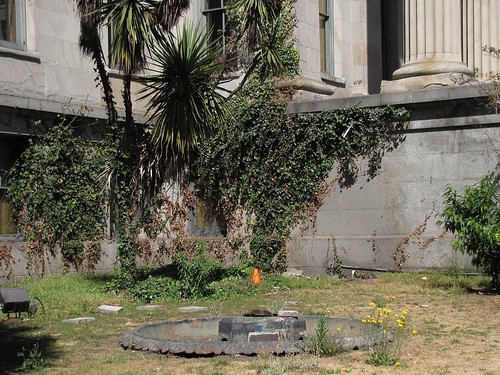
Before

After
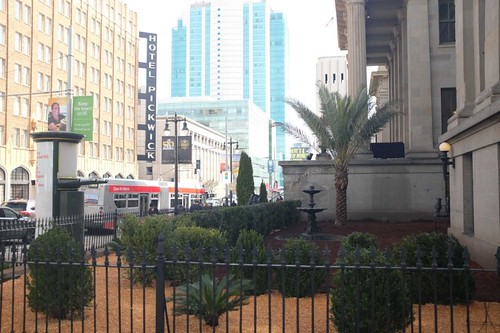
After
The refuse is gone, the ground raked and replaced with mulch and pea gravel. Palm trees and evergreen shrubs rise up where weeds once sprouted. The rusty iron fence has been sanded down and repainted.
No one bivouacs next to the front doors anymore.
Amazing what a difference hosting a Super Bowl makes!
To be fair, the transformation of the Old Mint began in earnest well before the Big Game festivities got rolling. But San Francisco definitely ramped up the makeover in recent weeks. For example, the mulch was just laid this week, and the paint on the historic lampposts, brushed on on Tuesday, is barely dry.
So apparently we can thank high-end football cleats for helping to make the Old Mint minty fresh.
To read the complete article, see:
Suddenly, the Old Mint is all
spiffed up for the Super Bowl (www.sfgate.com/bayarea/article/Suddenly-the-SF-mint-is-all-spiffed-up-for-the-6804131.php)
To read the earlier E-Sylum articles, see:
OLD SAN FRANCISCO MINT BUILDING ATTRACTS HOMELESS
(www.coinbooks.org/esylum_v18n24a38.html)
SIGNS OF RESTORATION AT OLD SAN FRANCISCO MINT
(www.coinbooks.org/esylum_v19n04a15.html)
THE ELUSIVE 1815 HALF EAGLE
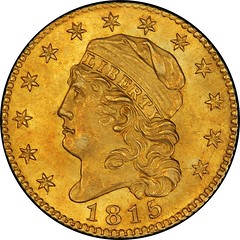
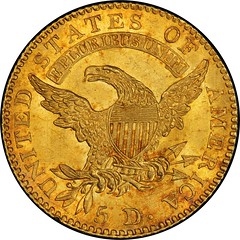
The War of 1812 was disastrous for the American economy. Following an ill-conceived embargo that punished Americans more than their enemies, incursions over the American border in 1813, and an invasion of the American capital in 1814, specie was hoarded and the economy ground to a halt. The Mint was all but shuttered for most of 1815, with the war preventing the importation of cent planchets from England and the economic issues manifesting in very few deposits of specie.
Only tiny deposits of gold came into the Mint, two of which arrived in 1815 and one of which remained leftover from late 1814, so it took but one day to produce the entire year’s production of half eagles. “The entire mintage of 635 coins was struck, probably in less than an hour, on November 3, 1815,” wrote Bill Eckberg in a 2015 article on the year’s coinage, published in Coin World. Researcher R.W. Julian calculated the number of 1815 half eagles given to each depositor: “Thomas Parker received 67 of the coins, Charles F. Kalkman another 210 pieces and the Bank of Pennsylvania was sent the rest, 358 pieces.” These 635 coins represented all the gold coins struck by the United States Mint in 1815, one of the smallest annual mintages of any denomination during the Mint’s long history.
While knowledge of American coins has evolved significantly over the last 150 years, the 1815 half eagle is one of only a few issues that have ever been seriously considered the rarest American coin. In April 1883, when S. Hudson and Henry Chapman offered an example of this issue to T. Harrison Garrett, they called it “the rarest coin of the U.S. regular series” and noted that “but four specimens of this date are known to exist, which cannot, we think, be said of any other date of U.S. coins.” They correctly added that the 1815 half eagle is “of greater rarity than the dollar of 1804” and surmised that “in a few years, when the collecting of gold develops, it will no doubt command a very large figure.”
Their prescience is borne out by auction data compiled by P. Scott Rubin. The next authentic 1815 half eagle to sell at auction after 1883 was the example in the H.P. Smith sale of 1906, which sold for $1,050. The next year, the Stickney coin brought $2,000, and prices continued to increase thereafter.
This example, once part of the Virgil Brand Collection, is almost certainly the example purchased by Brand from the Guttag Brothers in 1925. Brand owned two 1815 half eagles. One was acquired for $200 in 1899 from the relatively obscure German-born dealer M. David in a transaction that included the Eliasberg-Pogue 1822 half eagle. At the time, $200 was an inexpensive price for an 1815 half eagle.
Extensive research on this issue by Saul Teichman and the team of David Stone and Mark Van Winkle has found only ten known specimens. These experts, the grading services, and all other authorities agree: there is no finer specimen than this one. The provenance of each specimen has been rendered in detail by Stone and Van Winkle in The 1815 Half Eagle: New Discoveries, which has revealed that the specimen long thought to be in the Connecticut State Library is actually an altered 1813 half eagle and confirms that the example Joseph J. Mickley said was in the Swedish Mint cabinet really does exist. Purchased in 1851 “with 19 other gold coins from other countries,” the example in the Kungliga Myntkabinettet in Stockholm is illustrated and described in The 1815 Half Eagle.
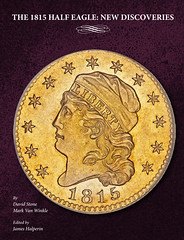 To read the complete lot description, see:
To read the complete lot description, see:
1815 Capped Head Left Half
Eagle. Bass Dannreuther-1. Rarity-7. (www.stacksbowers.com/BrowseAuctions/LotDetail/tabid/
227/AuctionID/6074/Lot/3149/Default.aspx)
For more information on the book, see these earlier E-Sylum articles:
NEW BOOK: THE 1815 HALF EAGLE (www.coinbooks.org/esylum_v15n53a03.html)
BOOK REVIEW: THE 1815 HALF EAGLE (www.coinbooks.org/esylum_v16n01a09.html)
MORE THOUGHTS ON THE FUTURE OF NUMISMATICS
The article by Dick Johnson about the future of numismatics brought up several interesting points. One of the first questions both collectors and investors ask is "what's it worth?" Prices for top items in early 2016 have escalated to levels thought impossible just a few years ago. Coins from the Pogue Collection are the perfect example. These are the finest of the finest and are setting records when sold. I don't know the number of coins that have sold for more than $1,000,000.00 but price levels once thought impossible are now commonplace.
No one can predict the future. Predicting the future is an exercise in extrapolating existing trends or thinking outside the box and foreseeing what might well seem an unrealistic future.
Mr. Johnson's prediction "1. The churning of rare coin sales at auctions among investors at ever increasing prices – like the Dutch tulip craze -- will someday bust. Prices will fall to a sustained level supported only by collector interest."
How many times in the past have these words been spoken? What seemed like market peaks, "prices CANNOT go higher", have proven over time to be conservative values.
I believe what makes today different is globalization. The number of people with more wealth throughout the world is expanding at an accelerating rate. Millionaires are increasing at an astounding rate. According to the Forbes report released in March 2015, there are currently 1,826 U.S. dollar billionaires worldwide, from 66 countries.
Art and collectibles are examples of alternative assets that are growing in popularity among wealthy individuals worldwide.
Using globalization and rapidly growing personal wealth as evidence, I challenge Mr. Johnson's prediction...
"The churning of rare coin sales at auctions among investors at ever increasing prices – like the Dutch tulip craze -- will someday bust. Prices will fall to a sustained level supported only by collector interest."
Yes, markets always have and always will experience boom and bust cycles. But long term I do not foresee Mr. Johnson's prediction as the outcome for the rare coin market.
To read the earlier E-Sylum article, see:
DICK JOHNSON'S PREDICTIONS FOR THE FUTURE OF NUMISMATICS
(www.coinbooks.org/esylum_v19n05a19.html)
THE BOOK BAZARRE
HIGHLIGHTS OF THE ARCHIVES FEBRUARY 23, 2016 SALE
Lot 50: Chile Province of Valdivia Treasury and Customs, 1840s Issue Rarity
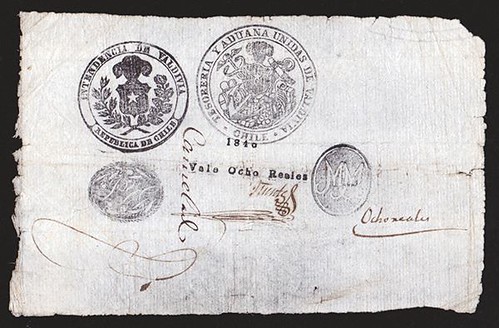
Chile. Tesoreria y Aduana Unidas Valdivia, 8 Reals. P-S102. Date and value printed at center. Various hand stamps signatures and denomination validation around. Fine to Very Fine, irregular edge. A very scarce issue.
To read the complete lot description, see:
Province of
Valdivia Treasury and Customs, 1840s Issue Rarity.
(http://auction.archivesinternational.com/Province-of-Valdivia-Treasury-and-Customs-1840s-Issue-Rarity_i24117178)
Lot 243: Chihuahua, Mexico, 1880, 1 Peso,
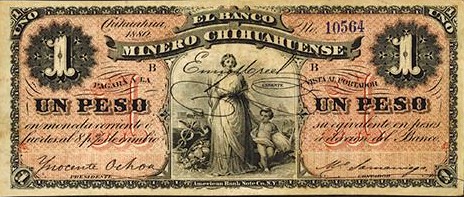
Chihuahua, Mexico, 1880, 1 Peso, Series B, P-S176a, BK-CHI-65, M149a, Issued banknote, black on light red underprint, standing allegorical woman with child in middle, S/N 10564, pp B, PMG graded Choice Very Fine 35 with large margins, firm paper and rarely seen this nice. ABNC.
To read the complete lot description, see:
Banco Minero Chihuahuense, 1880
Issue Banknote (http://auction.archivesinternational.com/Banco-Minero-Chihuahuense-1880-Issue-Banknote_i24117371)
Lot 247: Chihuahua, Mexico. 1886, 1 Peso
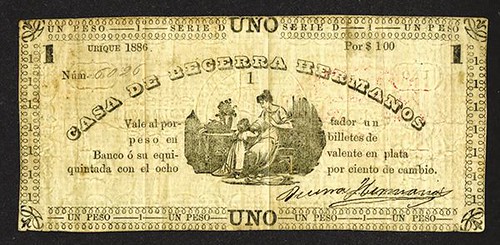
Unique, Chihuahua, Mexico. 1886, 1 Peso, Serie D, P-UNL, M665, PR-Chi-24, Issued banknote, S/N 6026, black on off white toned paper, Seated allegorical woman in middle, Printed back with logo in middle with oval red overprint "Hacienda Santa Rita - Guazapares - Nov. 6, 1886", PMG graded Very Fine 25. Extremely Rare. First time offered by us.
To read the complete lot description, see:
Casa De Becerra
Hermanos, Urique, 1886 Scrip Note Rarity.
(http://auction.archivesinternational.com/Casa-De-Becerra-Hermanos-Urique-1886-Scrip-Note-Rarity_i24117375)
Lot 298: Philippines. 500 Pesos
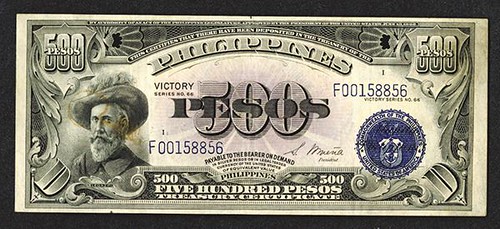
Philippines. 500 Pesos. P-101c. Legazpi at left. Series 66 printed twice rather than date. Two signatures on back exhibiting slight ink burn. Nice Very Fine.
To read the complete lot description, see:
Philippines Treasury. 1944 ND
VICTORY Issue. (http://auction.archivesinternational.com/Philippines-Treasury-1944-ND-VICTORY-Issue_i24117426)
Lot 310: San Juan, Puerto Rico 1889 20 Pesos
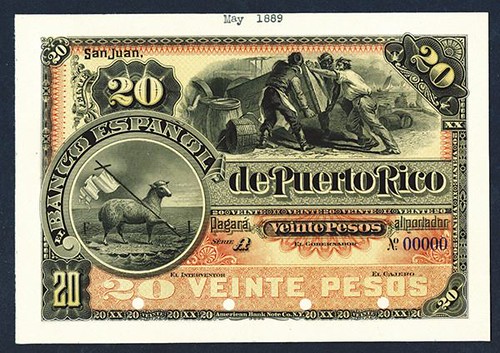
San Juan, Puerto Rico, ND (1889), 20 Pesos, P-10p, Unlisted Proof, Series A, S/N 00000, Black on orange and yellow underprint, Paschal lamb on left, dock workers moving crate on top right, back orange-brown with arms in middle, POC's, The face is PMG graded Gem Uncirculated 66 EPQ, the back is Choice Uncirculated 64 NET with notation of discoloration due to the oxidation of the orange color to orange-brown, otherwise an extremely attractive and rare note missing from most advanced collections. ABNC. This is the only graded example by PMG.
To read the complete lot description, see:
Banco
Espanol De Puerto Rico, ND (1889) Issue Front & Back Proof Banknote.
(http://auction.archivesinternational.com/Banco-Espanol-De-Puerto-Rico-ND-1889-Issue-Front-Back-Proof-Banknote_i24117438)
Lot 509: Buffalo State Line Rail Road Stock Certificate
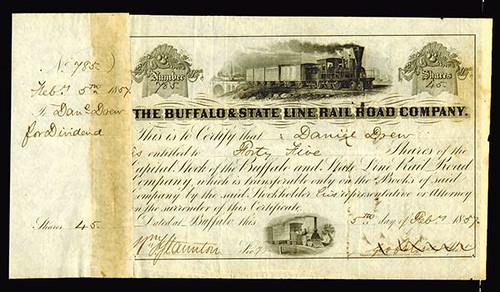
Buffalo, NY. 45 Shares, I/C, Locomotive L-R with city in background, old fashioned locomotive on bottom, ITASB Daniel Drew on the back. Drew was one of the original Robber Barons with Jay Gould and James Fisk. He started in the cattle business and moved into the trading of stocks and bonds in the 1840's. Rare signed certificate by Drew. (From the collection of John E. Herzog)
To read the complete lot description, see:
Daniel
Drew Signed 1857 Buffalo & State Line Rail Road Company Stock Certificate
(http://auction.archivesinternational.com/Daniel-Drew-Signed-1857-Buffalo-State-Line-Rail-Road-Company-Stock-Certificate_i24117637)
Lot 569: Liberty Loan Bond of 1917
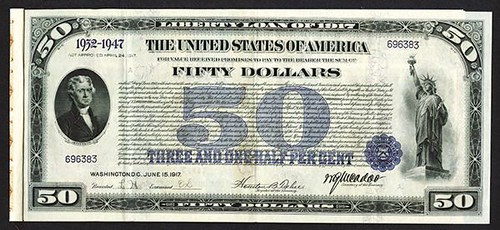
$50, Jefferson on left and Statue of Liberty on right, Bond grades VF-XF, all coupons attached, S/N 696383, BEP
To read the complete lot description, see:
Liberty Loan
Bond of 1917, 3 ½% Bond of 1932-1947. (issued June 15, 1917).
(http://auction.archivesinternational.com/Liberty-Loan-Bond-of-1917-3-Bond-of-1932-1947-issued-June-15-1917_i24117697)
Lot 682: American Bank Note Co. Color Chart Book
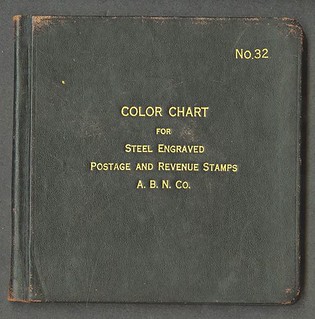
United States. Book titled: Color Chart for Steel Engraved Postage and Revenue Stamps. A.B.N.Co. No 32. 4-7/8 square. Each page consists of eight stamp images plus an ABNC eagle logo. The book contains 23 intaglio printed pages each with an interleaf. Colors from light to dark in tone: oranges, reds, blues, black. A seldom seen in-house salesman item. Slight handling evident. Previous owners name stamped on flyleaf endpaper. Book smells musty from long storage, mentioned for accuracy.
To read the complete lot description, see:
American Bank Note Co. Color Chart
Book. (http://auction.archivesinternational.com/American-Bank-Note-Co-Color-Chart-Book_i24117810)
Lot 728: 71st Pennsylvania Sutler Scrip Note
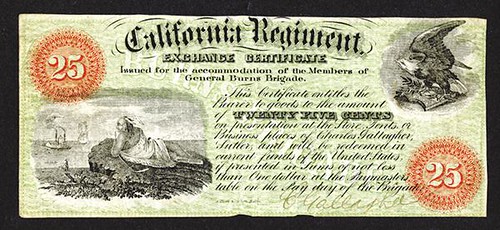
California and Pennsylvania. 71st Pennsylvania (California Regiment) of General Burns Brigade. 25 cents, Issued Sutler scrip note signed by Charles Gallagher, Sutler, Keller OA-SF025, Black on light green underprint with red denomination counters, Native American "Progress" vignette of Indian watching ships on the shore on lower left and eagle on upper right, printed on white paper with blank back, Choice Fine condition with firm paper body, no edge faults or other issues, bright colors and sharp corners only enhance this lovely and rare note. Originally, the California Regiment was begun by Californians living in Washington, D.C. in May 1861, eventually it was taken over by the 71st Pennsylvania. Printed by A.Hoen Co., Lith, Baltimore. Rare and very attractive note that should command a superior bid.
To read the complete lot description, see:
California
Regiment Exchange Certificate, ND (ca.1860's) Issued Sutler Note.
(http://auction.archivesinternational.com/California-Regiment-Exchange-Certificate-ND-ca-1860-s-Issued-Sutler-Note_i24117856)
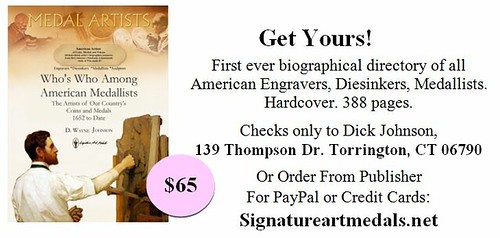
BONHAM'S OFFERS 1993 NOBEL PRIZE IN CHEMISTRY MEDAL
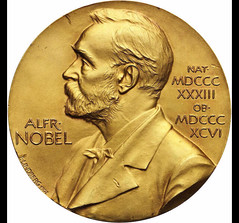

Dr. Kary Mullis' 1993 Nobel Prize in Chemistry, awarded to him for the invention of the Polymerase Chain Reaction (PCR).
Nobel medal, struck in 18 carat gold and plated in 24 carat gold, approx. 175g, 66 mm in diameter. Gem Brilliant Uncirculated. The obverse exhibits lovely copper red gold color, while the reverse is more of a bright yellow gold throughout. The obverse with two minor scuffs at 11:00 and 2:00, the reverse with minor marks in the central fields, otherwise as issued, with no sign of friction or wear. Housed in original claret diced morocco case, decorated in gilt and lined in satin.
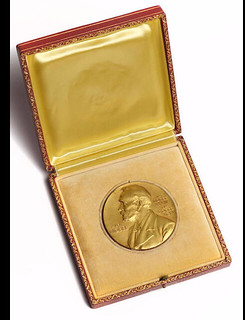 WITH: Kary Mullis' 1993 Nobel Prize Diploma, two vellum leaves (each 341 x 242 mm), the left featuring original watercolor art by Bo
Larsson, the right with the details of Mullis' award, in red morocco portfolio ruled in gilt and gilt-stamped "KBM," in custom
clamshell box.
WITH: Kary Mullis' 1993 Nobel Prize Diploma, two vellum leaves (each 341 x 242 mm), the left featuring original watercolor art by Bo
Larsson, the right with the details of Mullis' award, in red morocco portfolio ruled in gilt and gilt-stamped "KBM," in custom
clamshell box.
Together with a signed offprint of "Specific Enzymatic Amplification of DNA In Vitro: The Polymerase Chain Reaction" (Cold Spring Harbor Symposia on Quantitative Biology, Vol LX 1986); a signed copy of Mullis' 1993 Nobel lecture; a signed copy of Mullis' book Dancing Naked in the Mind Field; TLSs of Bill Clinton and Hillary Clinton to Kary Mullis; and 5 photographs, both color and black and white, of Mullis at the Nobel ceremonies and the White House.
Dr. Mullis' invention has allowed modern science to follow through on the promise of Watson and Crick's discovery of the double helix, allowing for the fuller and more comprehensive study of the mysteries of DNA.
"Take all the MVPs from professional baseball, basketball, and football. Throw in your dozen favorite movie stars and a half dozen rock stars for good measure, add all the television anchorpeople now on the air, and collectively, we have not affected the current good or the future welfare of mankind as much as Kary Mullis."
—Ted Koppel, ABC News-Nightline
To read the complete lot description, see:
DR. KARY MULLIS' 1993 NOBEL PRIZE IN CHEMISTRY, AWARDED TO HIM FOR THE
INVENTION OF THE POLYMERASE CHAIN REACTION (PCR). (www.bonhams.com/auctions/23255/lot/93/)
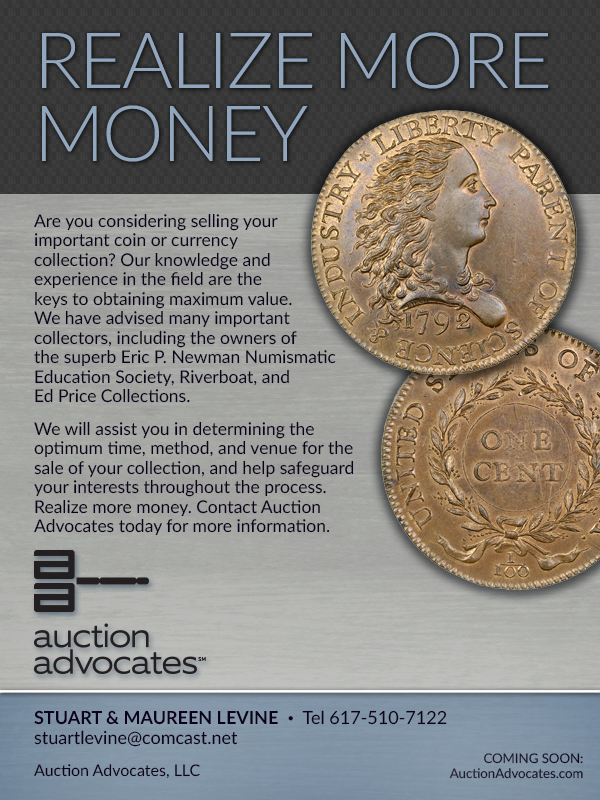
MILTON BRADLEY’S EDUCATIONAL TOY MONEY
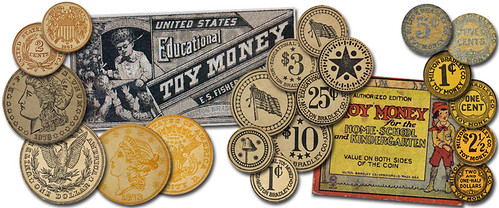
A fascinating and under-studied group of exonumia is that of play money, coins and currency made to be used by children in play or in an educational setting. These items are distinct from game money used in the context of a board game, or gaming counters used by adults in card games or gambling, but are often grouped in incorrectly with this group. In the United States, the Milton Bradley Company of Springfield, Massachusetts was the pioneer of play money, largely as part of their founder’s involvement in the kindergarten movement.
Though primarily known for his involvement with board games, Milton Bradley became involved with early childhood education starting in 1869 after attending a lecture by Elizabeth Peabody, the educator who opened the first English language kindergarten in the United States. From this point on, Bradley utilized his company to manufacture a wide array of items to be used in a kindergarten classroom. Many of these items he freely gave away.
The first iteration of play money made by Bradley bears dates ranging from 1853-1879 and is printed on white cardboard with a near-exact representation of the coins of the era. Denominations include: cent, two-cent piece, nickel, dime, quarter, half dollar, silver dollar, quarter eagle, three dollar gold piece, half eagle, eagle and double eagle. These “coins” are not marked as play money in any way. The ink used to print the coins varies, with some sets produced with black ink only, while others have copper ink for the copper coins, and gold ink for the gold. The box in which the author’s coins reside bears a patent date of March 20, 1877, however this same box cover and patent date were used for later styles as well. The underside of the lid of this set reads in part:
“This is an exact Fac-simile, on cardboard, of the common current coins in use, making not only an exceedingly amusing but at the same time a very instructive toy, the playing with which must of necessity impress upon the youthful mind the value of the different coins and the art of making change with ease and accuracy, thereby laying the foundation for Elementary Arithmetic, even in the nursery.”
The likeness was so similar in fact, that the U.S. government decided to intervene and instructed the company that they must come up with a new design.
The second type, made in response to government intervention is also printed with black ink on white cardboard, bears no dates, and displays the denomination on the obverse with EDUCATIONAL TOY MONEY / MILTON BRADLEY CO around the periphery. The diameter remains equivalent to the coins they imitate while the images vary depending on the composition. For the two “copper” coins, a Phrygian cap and pole is depicted; the nickel through dollar bear a simple star with five dots between the points; and the gold denominations bear a 31-star American flag with a Phrygian cap at the top of the pole. Though the box cover is identical to the previous set, the underside now reads in part:
“The legislation relating to printed money recently aimed at some of the bills used by commercial schools, and for advertising purposes, has been interpreted to also cover our Toy Money, as originally published. In order to strictly comply with the laws and in order to protect dealers and users of our money we have prepared new designs of the exact size of the actual coin.”
Both of the previous types seem to be quite scarce, and finding sets with the original boxes can be quite a challenge. Fortunately, a third type exists that proves somewhat easier to find. These types are once again produced in the familiar denominations and keep the proper diameters of the coins of the era. Once again, no dates are present on the coins, but these bear the denomination on both sides, once in text within an ornamental fame and once with numerals. Around the peripheries of both sides is printed MILTON BRADLEY CO. / TOY MONEY. Two variations exist for this type.
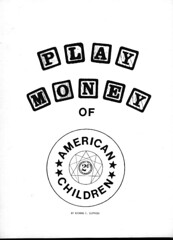 For more on play money, you might seek out a copy of Richard Clothier’s 1985 Play Money of American Children, though original copies
are quite scarce. Fortunately, the author is kind enough to provide images of the book in its entirety, available to print at http://rfc33.tripod.com/ .
For more on play money, you might seek out a copy of Richard Clothier’s 1985 Play Money of American Children, though original copies
are quite scarce. Fortunately, the author is kind enough to provide images of the book in its entirety, available to print at http://rfc33.tripod.com/ .
To read the complete article, see:
Milton Bradley’s Educational Toy Money – Part One (www.stacksbowers.com/NewsMedia/Blogs/TabId/780/ArtMID/
2678/ArticleID/65569/Milton-Bradley%E2%80%99s-Educational-Toy-Money-%E2%80%93-Part-One.aspx)
ANS ACQUIRES BANKSY £10 DIANA NOTE

The ANS recently acquired a £10 “Di-faced” banknote created by the street artist Banksy (active 1992–). The note was purchased at the 2016 New York International Numismatic Convention (NYINC) from Joseph Linzalone of Wolfshead Gallery, who, along with James Hallgate (a Banksy dealer) of Lucius Books, had jointly obtained eight of these specimens directly from Banksy’s manager in 2014.
The note parodies British £10 notes from the mid-2000s, replacing the face of Queen Elizabeth II with that of Diana, Princess of Wales. The elaborate script at the top of the note’s obverse reads, “Banksy of England”, replacing “Bank of England.” The reverse of the note remains largely unchanged except for the all-caps legend “trust no one” in the lower-right corner. Weighing ca. 1.32 g, the note is printed with inks on paper nearly identical to that used on official, UK-issued currency.
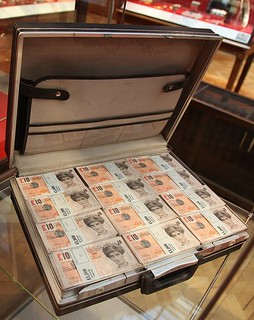 Banksy, known for his satirical and subversive street art, created a large quantity of the Princess Diana notes in August 2004, a roll of
which was reportedly thrown into the crowd at the Notting Hill Carnival and at the Reading Festival that year. Some of these bills were used by
festival-goers as actual currency, prompting Banksy to cease distribution. He re-used the note’s image later in a lithograph commemorating Princess
Diana’s death, and also in 2009’s “Million-Pound Briefcase”. Uncut sheets of these notes have fetched as much as £16,000 and £24,000 at auction.
Banksy, known for his satirical and subversive street art, created a large quantity of the Princess Diana notes in August 2004, a roll of
which was reportedly thrown into the crowd at the Notting Hill Carnival and at the Reading Festival that year. Some of these bills were used by
festival-goers as actual currency, prompting Banksy to cease distribution. He re-used the note’s image later in a lithograph commemorating Princess
Diana’s death, and also in 2009’s “Million-Pound Briefcase”. Uncut sheets of these notes have fetched as much as £16,000 and £24,000 at auction.
Perhaps the most unique aspect of the note the ANS acquired is its secure provenance. Genuinely authentic Banksy banknotes are exceedingly rare, and are often counterfeited/copied and sold online via auction sites such as ebay. Most sellers claim to have been at either the Nottingham Carnival or Reading Festival in 2004, and the fake notes sold are either photocopies or printed scans.
The market for Banksy notes is so great that it has generated detailed online discussions and videos of how to spot fakes. Many of the Princess Diana notes are listed online as auctions at between $200 and $600, nearly all of which are private listings that mask bidders’ identities and allow the seller to drive up the bids using shell ebay accounts. People interested in acquiring an authentic Banksy note should work through a reputable dealer or auction house.
The ANS’s Banksy note (ANS 2016.9.1) is the first specimen of fine-art paper currency at the Society, joining several examples of defaced/modified coins in the cabinet. Visitors to the ANS may schedule a time to see the Banksy note, or other items in the collection.
To read the complete article, see:
ANS ACQUIRES AUTHENTIC BANKSY £10 DIANA NOTE (www.anspocketchange.org/banksy/)
THE BOOK BAZARRE
THE CHEMICAL COMPOSITION OF ANCIENT COINS
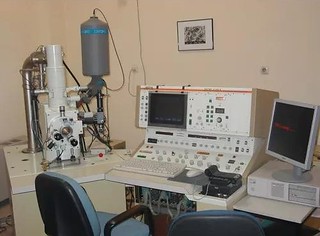 The determination of the chemical composition of ancient coins may offer valuable information to archeologists, historians and
numismatists, mainly regarding their manufacturing technology, age, minting places, and authenticity. The composition of the major elements can
provide useful information about the history and the economy of a city, a kingdom or an empire, for a specific period of time, and also about the
materials technology applied for the production of metal alloys. In the case of trace elements, their detection or not in the coins under examination
may provide indications about the source of the ores (determination of the metal’s provenance) and the manufacturing procedure. Moreover, the
composition of ancient coins can assist the discrimination between genuine and forged coins. Even though the analytical studies of coins have been
already carried out for more than 50 years, the relatively recent development of non-destructive analytical techniques has opened new potentials for
the analysis of coins with no or minimal damage caused, since museum curators and collectors do not allow any permanent damage to the coins, even of
those in poor condition.
The determination of the chemical composition of ancient coins may offer valuable information to archeologists, historians and
numismatists, mainly regarding their manufacturing technology, age, minting places, and authenticity. The composition of the major elements can
provide useful information about the history and the economy of a city, a kingdom or an empire, for a specific period of time, and also about the
materials technology applied for the production of metal alloys. In the case of trace elements, their detection or not in the coins under examination
may provide indications about the source of the ores (determination of the metal’s provenance) and the manufacturing procedure. Moreover, the
composition of ancient coins can assist the discrimination between genuine and forged coins. Even though the analytical studies of coins have been
already carried out for more than 50 years, the relatively recent development of non-destructive analytical techniques has opened new potentials for
the analysis of coins with no or minimal damage caused, since museum curators and collectors do not allow any permanent damage to the coins, even of
those in poor condition.
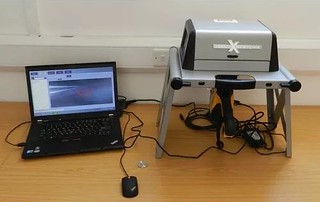 In this paper, the most common techniques which are used or have been used for the analysis and the determination of the chemical
composition of ancient coins, along with their advantages and limitations, will be presented, without providing much information about the
methodological aspects of the techniques.
In this paper, the most common techniques which are used or have been used for the analysis and the determination of the chemical
composition of ancient coins, along with their advantages and limitations, will be presented, without providing much information about the
methodological aspects of the techniques.
To read the complete article, see:
Analytical methods for the determination of the chemical composition of ancient coins
(http://kyprioscharacter.eie.gr/en/scientific-texts/details/numismatics/analytical-methods-for-determination-of-chemical-composition-of-ancient-coins)
SCIENTIST MARY SOMERVILLE LEADS VOTING FOR SCOTLAND BANKNOTE

How the Somerville tenner might look
Pioneering scientist Mary Somerville is poised to make banknote history.
The 19th-century astronomer and mathematician is set to be the first woman other than the Queen to appear on a Royal Bank of Scotland note.
She is way out in front in a public ballot to choose the face of the RBS’s new polymer £10 note.
Voting closes at midnight tonight but Jedburgh-born Mary has twice as many votes as her closest rival, physics genius James Clerk Maxwell.
Engineer Thomas Telford, known as the Colossus of Roads, is in third place.
Mary has support in high places, including Holyrood presiding officer Tricia Marwick. On the RBS Facebook page, she wrote: “A committee room named after her in the Scottish Parliament. Now let’s get her on a banknote.”
Dame Anne Glover, the former chief scientific adviser for Scotland, said: “All the scientists proposed are outstanding.
“But I’d like to see Mary as she was a true pioneer, a woman in what was definitely a man’s
world. She was inspirational. Her thinking probably helped James Clerk Maxwell, for example. And she definitely pushed forward our understanding of our world and its place in the universe.”
Mary, who was born in 1780, was the daughter of a naval officer.
She grew up in a time when girls were discouraged from learning and she was forced to study in secret. Her work in astronomy led to the discovery of the planet Neptune.
To read the complete article, see:
19th-century
pioneer scientist Mary Somerville set to make history as the new face of RBS polymer banknote
(www.dailyrecord.co.uk/news/scottish-news/19th-century-pioneer-scientist-mary-7324165#k5WuyzAY6iVEIabF.97)

THE BUSINESS OF THE TRIAL OF THE PYX
 While central banks debate the merits of a purely electronic, cashless society, a near-800 year old ceremony to test Britain’s coinage is
taking place in a quiet corner of London.
While central banks debate the merits of a purely electronic, cashless society, a near-800 year old ceremony to test Britain’s coinage is
taking place in a quiet corner of London.
It might sound like something out of Harry Potter, but the Trial of the Pyx is real and has been conducted in London yearly since the late 13th century.
The ceremony, conducted in Goldsmiths’ Hall, puts the Royal Mint on trial. Around 96,000 coins are scrutinised over a four month period.
The coins are “assayed” or tested for imperfections and impurities in the metals used to make them, to confirm their value.
A sample of all the coins made by the Royal Mint are tried in this way — from a £1,000 pound commemorative coin made from a kilo of solid gold, down to the lowly 20p piece.
The opening of this year’s trial was on February 2nd was full of pomp and circumstance. It’s carried out by the Queen’s Remembrancer, a judge, who swears in the 16-strong jury who have the job of counting the coins sent for testing by the Royal Mint.
While it’s mostly ceremonial, the Trial of the Pyx has an important message — merchants, not the state or the monarchy, must have power over the country’s currency. To allow the state to have power over the currency, risks eroding its credibility.
Permission for the City of London to test the coins produced by the Royal Mint was granted by the Crown in the 13th century. Before that, the reigning monarch had a monopoly on producing and testing Britain’s coinage and would periodically alter the standards for the coins to finance wars.
“There was the inherent danger of inflation and currency corruption,” the Queen’s Remembrancer, Barbara Fontaine, said in her speech to open proceedings. The Trial was “a key stage of development of the international trust in our coinage.”
To read the complete article, see:
Inside the bizarre and ancient coin-testing ceremony -- the Trial of the Pyx
(www.businessinsider.com.au/inside-the-trial-of-the-pyx-the-734-year-old-ceremony-that-asserts-the-citys-power-over-the-currency-2016-2#/#the-ceremony-takes-place-in-the-opulent-goldsmiths-hall-in-the-city-of-london-members-of-the-public-and-invited-dignitaries-are-sat-on-one-side-of-the-room-1)

Archives International Auctions, Part XXXI
U.S. & Worldwide Banknotes, Scripophily
Security Printing Ephemera
February 23rd, 2016
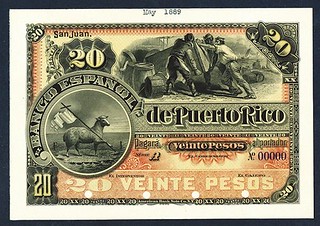
Click the links! Highlights include:
- Lot 50: Chile Province of Valdivia Treasury and Customs, 1840s Issue Rarity
- Lot 243: Chihuahua, Mexico, 1880, 1 Peso
- Lot 247: Chihuahua, Mexico. 1886, 1 Peso
- Lot 298: Philippines. 500 Pesos 1944 ND VICTORY Issue
- Lot 310: San Juan, Puerto Rico 1889 20 Pesos
- Lot 509: Buffalo State Line Rail Road Stock Certificate
- Lot 569: Liberty Loan Bond of 1917
- Lot 682: American Bank Note Co. Color Chart Book
- Lot 728: 71st Pennsylvania (California Regiment) Sutler Scrip Note
View the Virtual Catalog
Download the Catalog in PDF format
ARCHIVES INTERNATIONAL AUCTIONS, LLC
1580 Lemoine Avenue, Suite #7
Fort Lee, NJ 07024
Phone: 201-944-4800
Email: info@archivesinternational.com
WWW.ARCHIVESINTERNATIONAL.COM
MORE ON THE HIGHLAND MINT SUPER BOWL 50 COINS
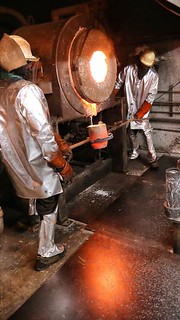 Forget about quarterbacks Cam Newton or Peyton Manning. The star of Sunday's Super Bowl 50 will be from Central Florida.
Forget about quarterbacks Cam Newton or Peyton Manning. The star of Sunday's Super Bowl 50 will be from Central Florida.
For approximately 1.5 seconds, viewers in 117 countries will watch a shiny round object born on Riverside Drive in Melbourne rotate through the air.
"It gives me goosebumps," Michael Kott said.
He owns the Highland Mint, which produced the official coin of Super Bowl 50. Tossing a metal object to determine which football team gets to have the ball first may not seem like a big deal.
But this is the Super Bowl. Everything is a big deal, especially if it can be reproduced, packaged and sold for $99.99.
Kott expects this year's limited-edition run of 10,000 coins to sell out, especially if the Denver Broncos beat the Carolina Panthers and the 39-year-old Manning rides triumphantly into the sunset. The first 100 coins were shipped to San Francisco last week for NFL honchos to toss around.
Kott bought the company in 1993 and started pursuing licensing deals. Now 150 employees crank out commemorative coins, ornaments, photos, cards and other collectibles for every major sport and more than 100 colleges.
The cheapest item is an $8.99 keychain. The most expensive is the $1,500 collection of all 50 Super Bowl coins.
Highland started producing them with Super Bowl XXVII. Getting the first one from the drawing board to the 50-yard-line is an ultra-high-priority job for Highland.
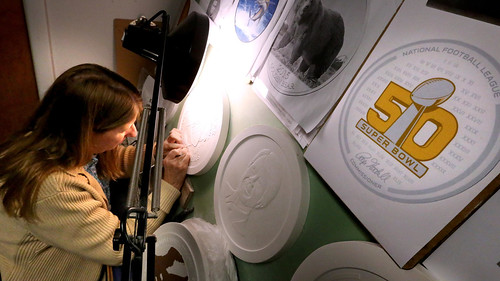
Sculptor Phylis Hamilton at Highland Mint
It begins even before the final two teams are known. Artwork of the Super Bowl's Vince Lombardi Trophy with a "50" was carved into a plaster disk. Logos of the Broncos and Panthers were added after they won their conference championship games two weeks ago.
That disk is put on a contraption that re-carves the artwork onto a disk that's one-ninth the size.
"It's like copying a key," Kott said as he guides visitors through the warehouse.
The air smells like cardboard and thumps with the sound of all sorts of machinery. Silver is loaded in 1,700-degree furnaces and comes out a glowing liquid at the bottom.
It's poured into cylinders, cooled, flattened, rolled and cut into 1-1/2-inch circles. The coins get a 30-minute wash in a special mixture, are dried in a spin machine and then fed by hand into a press.
BAM!
The die comes down, imprints the artwork and you have a pure silver coin.
The coins are whisked to a company in Rhode Island that adds the gold plating. Within 24 hours, the coins are back at Highland, where they are numbered, put in their fancy packaging and boxed for shipping.
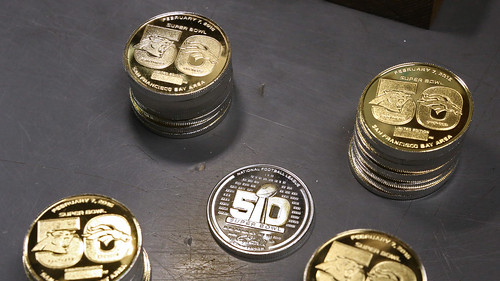
To read the complete article, see:
Super Bowl 50 coin toss begins in
Central Florida (www.orlandosentinel.com/sports/os-super-bowl-coin-highland-mint-0207-20160206-story.html)
To read the earlier E-Sylum article, see:
HIGHLAND MINT STRIKES SUPER BOWL 50 COINS
(www.coinbooks.org/esylum_v19n05a37.html)
THE HIGHLAND MINT'S DARK SECRET
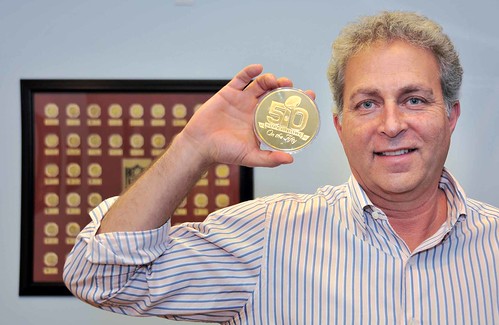
Michael Kott and the Super Bowl 50 coin
For all the attention paid to the flip, what’s mostly unknown is the story of the company that for 23 years has made the coin itself—and will sell you a limited-edition replica, encased in acrylic along with a certificate of authenticity, for $99.99. Highland Mint operates out of a palm tree-ringed warehouse in Melbourne, Fla., and has been owned by Michael Kott, 58, since 1993. That’s the same year the NFL decided it wanted to turn a profit off the ceremony that started its biggest game. Highland Mint, then a small memorabilia seller, bought the exclusive license to create a collectible coin, and has since acquired licenses for framed photos and replica tickets for the other three major sports leagues, the NCAA, and events such as the Kentucky Derby. A tour of the mint in January finds some 120 employees in room after room, designing and constructing collectibles that are sold online and at retailers such as Bed Bath & Beyond and Neiman Marcus.
In April 1993, Highland Mint was owned by a man named James Meadlock, and the company’s only products were licensed Major League Baseball memorabilia. Meadlock received an unsolicited call from Kott, who introduced himself as the owner of a Montreal-based collectible company called Madison Avenue Sports. According to a civil suit Meadlock would later file, Kott told Meadlock that he was interested in becoming Highland Mint’s sole Canadian distributor.
Meadlock flew to Montreal to meet Kott and his father, Irving. According to the suit, the Kotts almost immediately offered to buy the entire company. Meadlock agreed to a simple deal. In exchange for Highland Mint, he accepted 120,000 shares in a company called Hariston, the parent of Madison Avenue Sports. The Kotts portrayed Hariston as a company on the rise. They told Meadlock that it owned a successful supermarket chain in Poland that would soon make a killing by expanding into other Eastern bloc countries in the post-Cold War gold rush. Even more enticing, according to Meadlock’s suit, was Hariston’s proprietary technology, which the Kotts claimed could turn contaminated groundwater into valuable precious metals, a process they said was already employed at a mine in Butte, Mont., and would eventually be used worldwide.
The lawsuit Meadlock filed in Brevard County, Fla., in 1996, alleged that almost everything the Kotts told him wasn’t quite true. There were a few Polish grocery stores but no plans to expand. The groundwater cleanup technology was a bust in Butte. And Meadlock alleged that merchandise sold by Madison Avenue Sports had been artificially overvalued by a fake newsletter produced, in secret, by Madison Avenue Sports itself, and the company had been forced to buy back the products to pacify irate customers. (Irving Kott died in 2009. A motion to dismiss Meadlock’s suit was filed, but Michael Kott declined to comment on the matter.)
Meadlock discovered that Irving, a Montreal native, was well-known to securities regulators around the world. By the time of their initial meeting in Montreal, the elder Kott had survived two assassination attempts, including a prematurely detonated car bomb, described in the Canadian press as mob-related, and had received what was then the largest civil fine in Canadian history, for stock fraud. Irving had also run what Dutch authorities described as the most successful boiler room in the world.
According to FBI records, Irving first caught the attention of U.S. authorities in 1964, when he hosted a cocktail party in New York City to impress a mark who would later invest in a mining company secretly run by Irving. Thus began a pattern that would continue for the rest of Irving’s life. Shares in highly speculative companies sold by teams of brokers under his control would see their stock price rise spectacularly before falling off a cliff—classic pump-and-dumps.
In 2004, Mark Cuban, the billionaire owner of the Dallas Mavericks, invested in a promising Canadian Internet company called Mamma.com. Shortly after, Switlyk and others told Cuban that Mamma was secretly controlled by Irving. Cuban sold his stock—a trade that led to his being accused of insider trading by the SEC in 2008. By the time Cuban won his case in 2013, Irving had died peacefully in his Montreal mansion. Inspired by his experience with Irving, Cuban started a fraud-focused website called Sharesleuth that recently made Michael’s Highland Mint a target, accusing the company in an article of selling footballs and helmets with forged signatures, including those of Seattle Seahawks quarterback Russell Wilson, for as much as $2,500 apiece. Michael Kott, as well as Michael Goldfarb, the president of Who’s Who Productions, a company that supplied the goods, say they’re legitimate.
It can’t have been easy to run a small business for two decades with Kott for a last name. While his father was making enemies with the U.S. Attorney’s office and a billionaire reality TV star, Michael spent his time growing Highland Mint from nearly nothing into a leader in a market where authenticity is essential. So it’s understandable that Kott seems slightly uncomfortable with the idea of a visit from a reporter. “Is there any reason why you didn’t just call?” he says when I show up at the mint in January.
Kott relaxes a bit once he starts answering questions about his company, its flagship product, and the Super Bowl. The company was on the verge of failure when he bought it, he says, with just 20 employees. This year he expects to produce 10,000 Super Bowl coins, and he’s rooting for Denver, unsentimentally, because he thinks Broncos fans will buy the most coins.
It isn’t until after a tour of Highland Mint’s deafening factory floor that I mention Irving Kott. “I don’t really want to discuss that,” he says.
Kott presents himself as simply a business owner who’s constantly reinventing his company. Under Meadlock, he says, Highland Mint’s main products were replica trading cards sold via “little ma-and-pop stores.” Now it’s his hunk of metal that will be tossed skyward for a global TV audience on Feb. 7. As far as Kott is concerned, there are coins to be made, a Super Bowl to attend, and a past to leave right there, in the past. Or, as he frames it before putting an abrupt end to the conversation, “The sins of the father have nothing to do with the son, right?”
To read the complete article, see:
The Super Bowl Coin Toss Has a Dark Secret
(www.bloomberg.com/features/2016-super-bowl-coin-toss/)
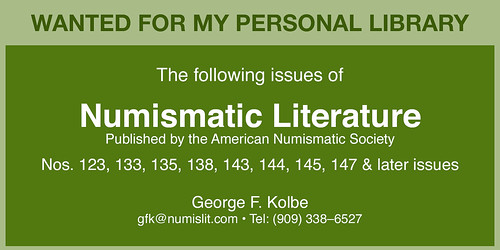
PARTIAL RECOVERY OF DOLSON POLITICAL MEDALS AND TOKENS
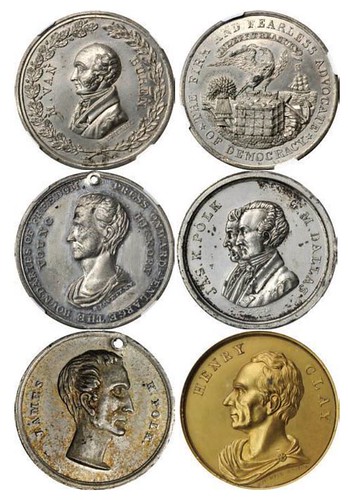 The Numismatic Crime Information Center is working closely with Detectives from the Louisville, KY police department and the victim
regarding the recent theft of the finest 19th Century Political/Campaign medal and badges collection valued at over $500,000.
The Numismatic Crime Information Center is working closely with Detectives from the Louisville, KY police department and the victim
regarding the recent theft of the finest 19th Century Political/Campaign medal and badges collection valued at over $500,000.
The on-going investigation has resulted in the recovery of 18 pieces from the stolen collection. The recovered items were sold to a Bethlehem,PA coin shop and were in the possession of an individual identified as a Jack Goldberg.
There is reason to believe that Jack Goldberg has in his possession or has immediate access to a substantial number of items from the stolen collection.
Jack Goldberg is 70 years old and a resident of Allentown, PA. Goldberg may also have a South Florida residence possibly in Boca Raton, FL or vicinity.
Anyone with information on this offense or knows subject Goldberg please contact:
Doug Davis
817-723-7231
Doug@numismaticcrimes.org
To read the complete article, see:
Partial Recovery
(http://campaign.r20.constantcontact.com/render?ca=5231db48-7267-40bb-99e7-d5a8fb59532b&c=b7717a30-4ea3-11e3-b18a-d4ae52754055&ch=b81d98b0-4ea3-11e3-b1e3-d4ae52754055)
To read the earlier E-Sylum article, see:
SCOTT DOLSON POLITICAL MEDALS AND TOKENS STOLEN
(www.coinbooks.org/esylum_v19n02a19.html)
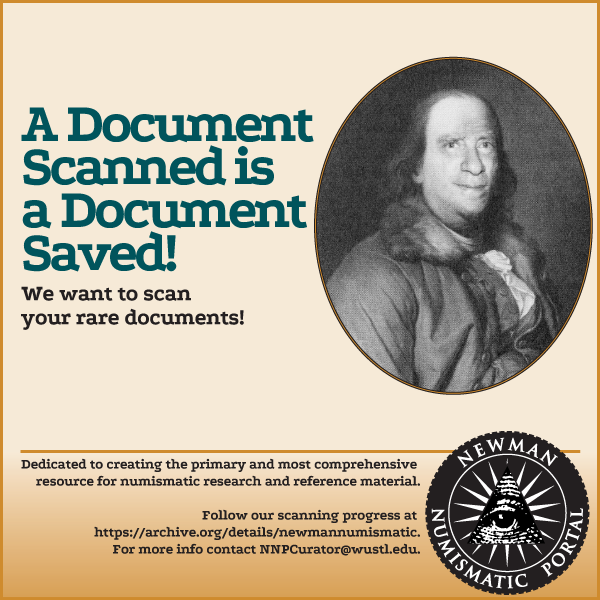
ARTIST CARVES BUFFALO NICKEL IN OREO COOKIE
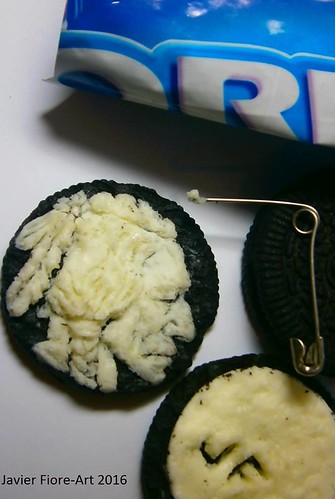
To read the complete articles, see:
Artist
plays with his food, etches 'Buffalo nickel' obverse into Oreo: Coin World Buzz
(www.coinworld.com/news/us-coins/2016/02/the-buffalo-indian-head-cent-depiction-has-landed-on-an-oreo-coin-world-buzz.html#)
Artist “Strikes” Buffalo Nickel in Oreo
(http://news.coinupdate.com/artist-strikes-buffalo-nickel-in-oreo/)


